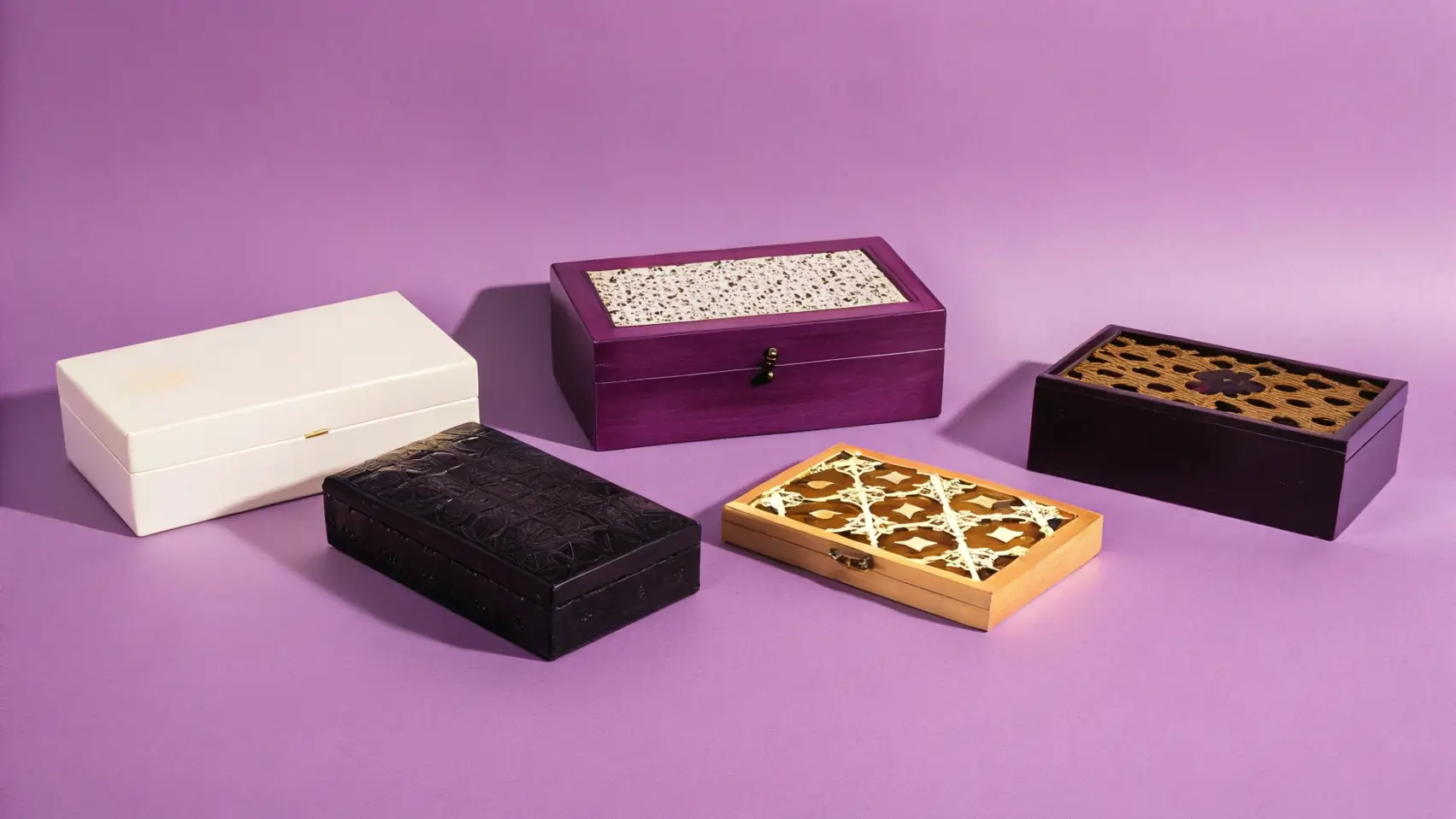
2025 Top 50 Unique Jewelry Box Ideas and 3 Key Tips
2025-02-17
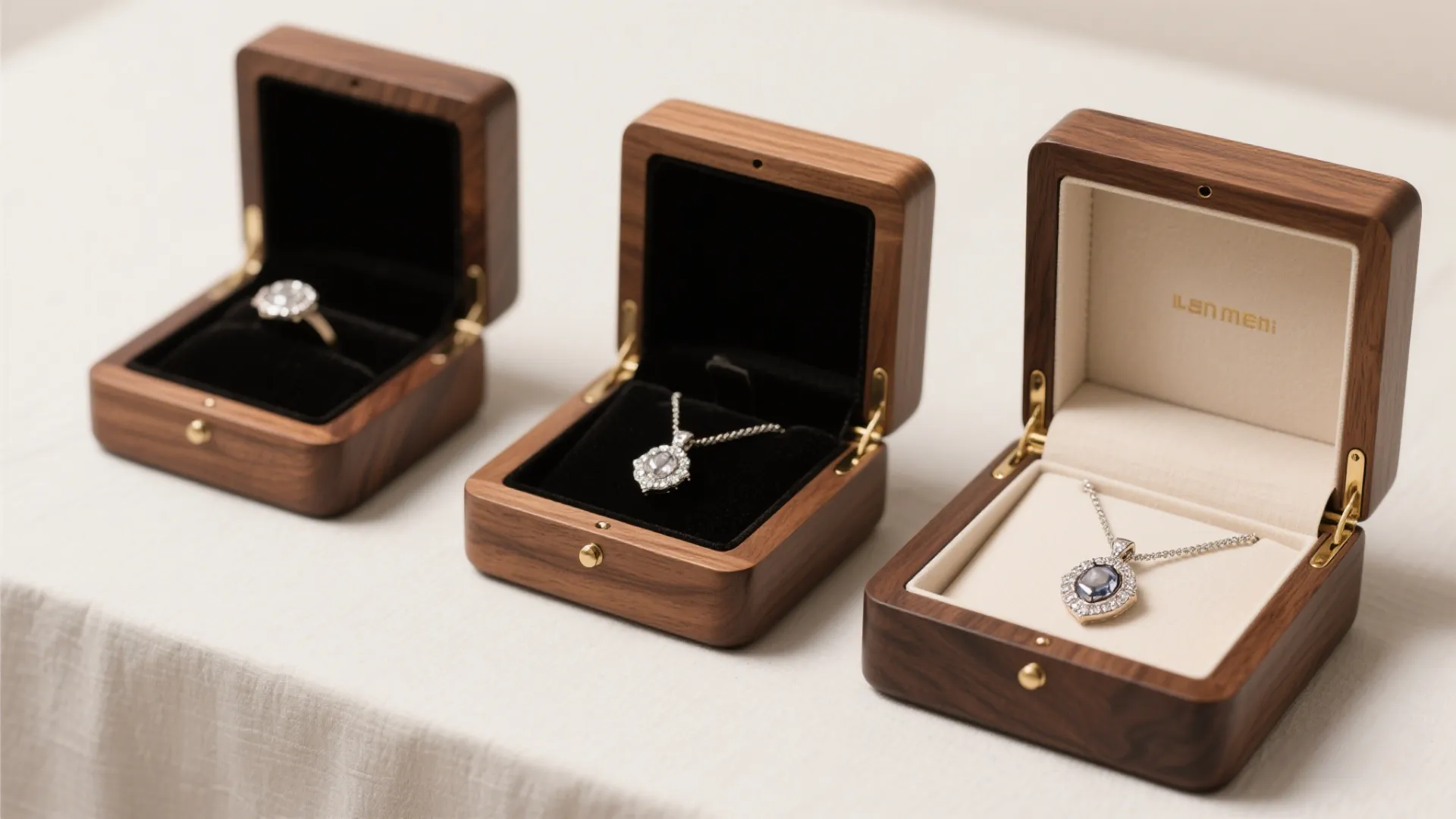
Wooden jewelry boxes represent the perfect marriage of functionality and artistry. These timeless pieces not only safeguard your precious gems and metals but also serve as beautiful decorative elements in your home. Whether you’re searching for inspiration to craft your own box or looking to purchase a handmade treasure, our comprehensive guide to wooden jewelry box designs will help you discover the perfect option for your needs. In this article, we’ll explore 50+ stunning wooden jewelry box designs ranging from classic to contemporary, simple to ornate, and practical to artistic. We’ll also cover the best wood types, interior lining options, and practical considerations to help you make informed decisions about these beautiful storage solutions.
Wooden jewelry boxes have been treasured storage solutions for generations, combining functionality with artistic craftsmanship. These beautiful containers do more than just organize your valuables—they tell stories, showcase exceptional woodworking skills, and often become cherished heirlooms passed down through families.
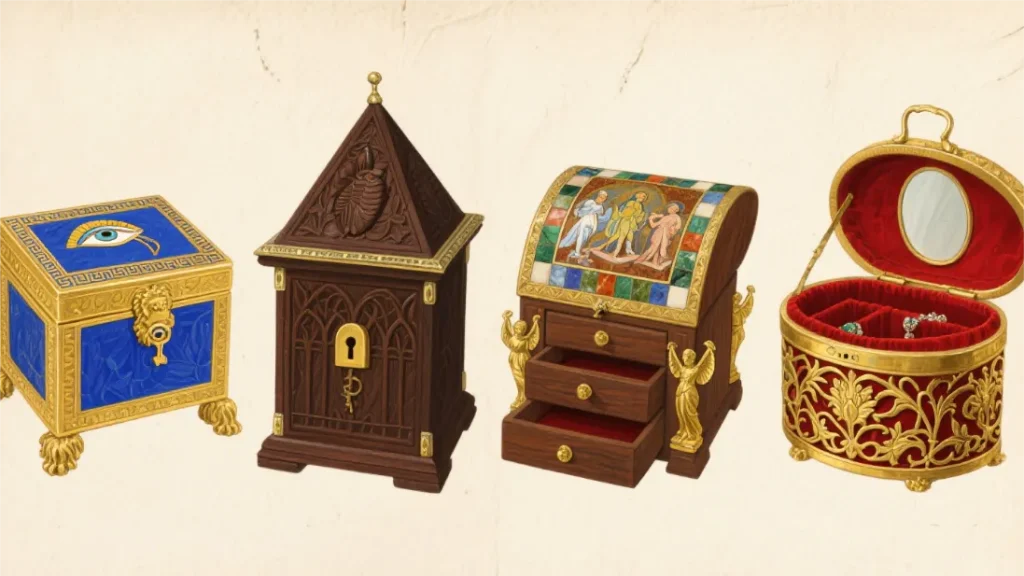
The history of jewelry boxes dates back thousands of years. Ancient Egyptians crafted elaborate containers from wood and precious materials to store their ornaments. During the Renaissance, intricate wooden caskets gained popularity among European nobility. By the Victorian era, jewelry boxes became common household items, often featuring velvet linings and complex compartments.
Today’s wooden jewelry boxes continue this rich tradition while incorporating modern design elements and functionality. They range from simple, elegant containers to complex pieces with multiple drawers, specialized compartments, and innovative features.
While many of the designs in this guide can be undertaken by skilled artisans, producing them at scale with consistent quality for a global brand requires specialized expertise. Leading suppliers like Richpack, with over 15 years of experience, provide end-to-end design, customization, and shipping services that empower brands like ZARA and Marks & Spencer to deliver exceptional packaging.
What makes wooden jewelry boxes so enduringly popular is the natural warmth and character of wood. Unlike plastic or mass-produced metal alternatives, wooden boxes develop a beautiful patina over time, with each scratch and mark telling a story of use and care. The natural grain patterns ensure that no two wooden boxes are exactly alike, even when crafted from the same design.
The ideal wooden jewelry box serves multiple purposes. A quality box should:
Beyond practical storage, wooden jewelry boxes also make strong aesthetic statements. They can complement your home décor, reflect your personal style, and showcase the beauty of natural materials. Whether displayed prominently on a dresser or tucked away in a closet, a well-crafted wooden box adds a touch of elegance to any space.
For woodworking enthusiasts, creating a jewelry box represents an achievable yet rewarding project. The relatively small scale allows for experimentation with joinery techniques, wood combinations, and finishing methods without overwhelming material costs or workspace requirements. Many woodworkers find that jewelry boxes offer the perfect canvas for developing their skills while creating something both beautiful and useful.
As we explore the 50 designs in this guide, you’ll notice how wooden jewelry boxes can range from minimalist to ornate, traditional to contemporary, and simple to complex. This versatility ensures there’s a perfect design for every aesthetic preference, skill level, and jewelry collection.
When selecting or creating a wooden jewelry box, consider not only its appearance but also how well it will serve your specific needs. Think about the types of jewelry you own, how you prefer to organize them, and where you’ll place the box in your home. The perfect wooden jewelry box is one that balances beauty, craftsmanship, and functionality in a way that resonates with your personal style.
The choice of wood dramatically impacts both the appearance and longevity of your jewelry box. The right wood species not only creates visual appeal but also provides the durability needed to protect your valuable collection. Understanding the characteristics of different woods helps you select the perfect material for your jewelry box project or purchase.
Hardwoods generally make the best jewelry boxes due to their density, strength, and beautiful grain patterns. Unlike softwoods, hardwoods resist denting and scratching, crucial qualities for an item that will be handled frequently. They also tend to age beautifully, developing character and patina over decades of use.
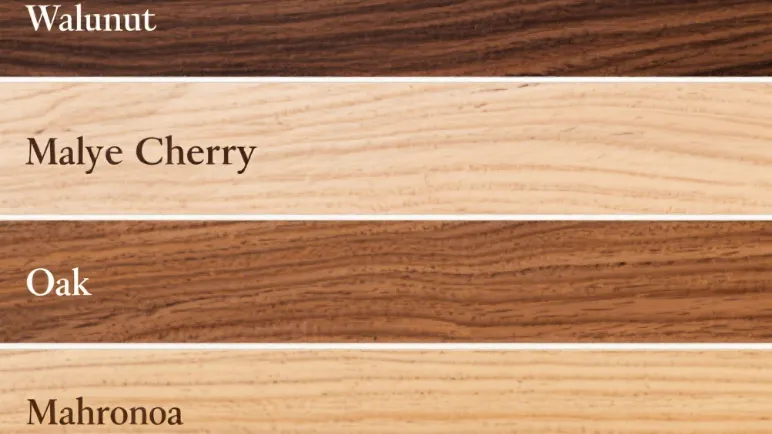
Walnut stands as one of the premier choices for fine jewelry boxes. Its rich, chocolate-brown color provides a sophisticated backdrop that makes gold, silver, and gemstones pop. American black walnut features straight grain with occasional swirls and burls that add character. The wood’s natural durability makes it resistant to warping, an essential quality for boxes that need to open and close properly for years. Walnut also takes finish beautifully, allowing craftsmen to enhance its natural luster.
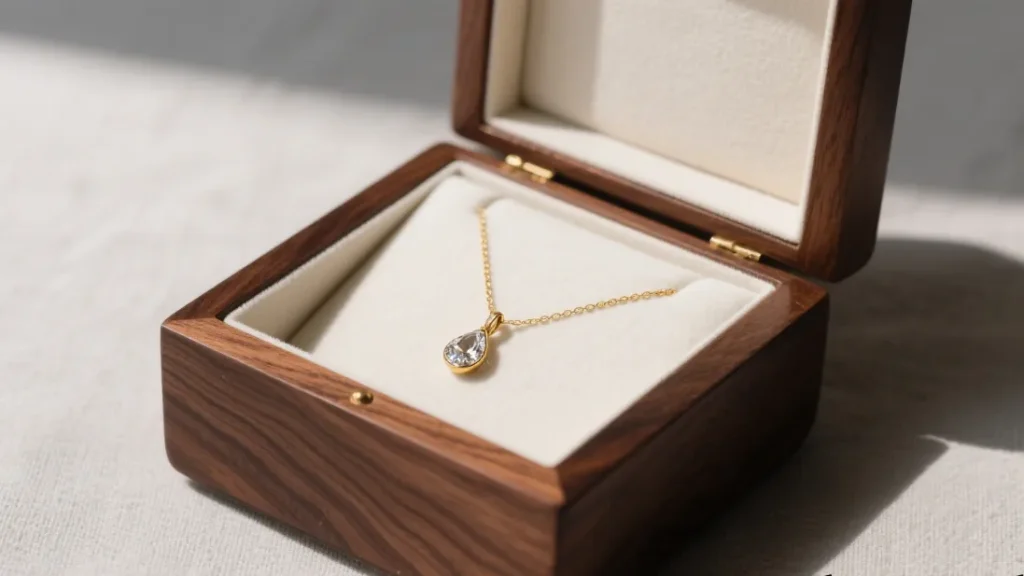
Maple offers a completely different aesthetic with its light, creamy color and subtle grain pattern. This hardwood’s clean appearance makes it particularly suitable for contemporary designs. Hard maple (also called sugar maple) provides exceptional durability and wear resistance. For truly distinctive jewelry boxes, look for figured maple varieties like birdseye, quilted, or curly maple. These special grain patterns create visual interest that makes each box one-of-a-kind.
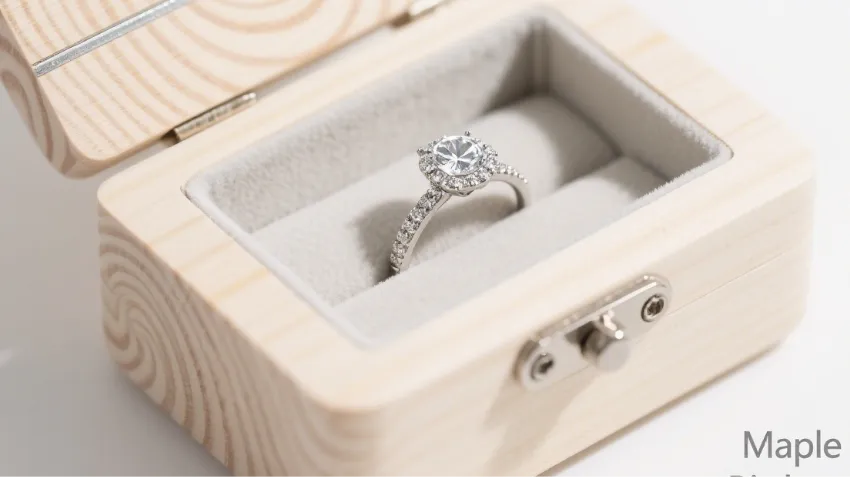
Cherry wood creates jewelry boxes with warm character and exceptional aging properties. Beginning with a light pinkish-brown tone, cherry naturally darkens to a rich reddish-brown with exposure to light over time. This gradual transformation gives cherry jewelry boxes a living quality that many collectors appreciate. The wood’s straight grain pattern, occasionally accented with small gum pockets and fine pith flecks, adds subtle visual interest without overwhelming delicate jewelry pieces.
Mahogany has been prized for fine furniture and decorative boxes for centuries, and for good reason. Its reddish-brown color provides richness and depth, while its exceptional stability ensures boxes that will function smoothly for generations. True mahogany (Swietenia species) has become rare and expensive due to conservation concerns, but related species like Sapele and African mahogany offer similar characteristics at more accessible prices. These woods feature interlocking grain patterns that create beautiful ribbon stripe or mottle effects when quarter-sawn.
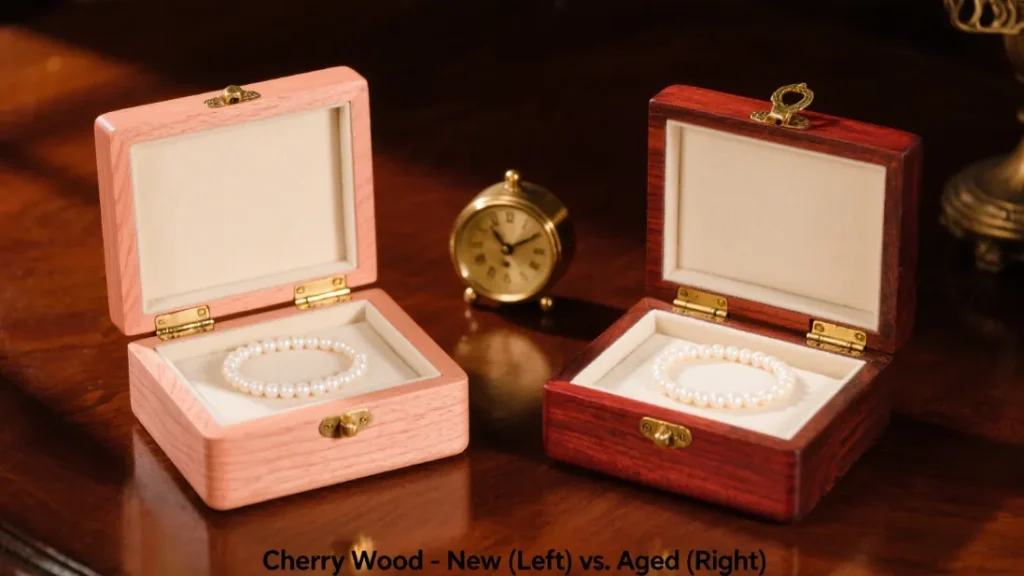
Oak creates sturdy, distinctive jewelry boxes with unmistakable grain patterns. White oak, with its longer rays and closed cell structure, generally works better for jewelry boxes than red oak. Quarter-sawn white oak displays beautiful fleck patterns (medullary rays) that have made it a favorite of craftsmen since the Arts and Crafts movement. Oak’s natural tannic acid content also makes it resistant to fungal decay and insects, contributing to its legendary durability.

For truly special jewelry boxes, exotic hardwoods offer unique colors and properties not found in domestic species. These woods typically command premium prices but provide unmatched visual impact and exclusivity.
Rosewood varieties (primarily Dalbergia species) create some of the most luxurious jewelry boxes available. These woods feature dramatic dark purple-brown to almost black coloration with contrasting lighter streaks. Brazilian rosewood, long considered the gold standard, is now protected and rarely available. However, East Indian rosewood and Cocobolo (a Central American rosewood species) offer similar beauty with deep red to orange hues and natural oils that create a smooth feel and lustrous finish without added sealants.
Bubinga, harvested from equatorial Africa, creates statement-making jewelry boxes with its striking reddish-purple color. Often featuring dramatic figuring patterns like pommele (a blister-like appearance) or waterfall mottle, bubinga boxes showcase nature’s artistry. The wood’s exceptional density (it often sinks in water) translates to remarkable durability and resistance to wear—perfect qualities for protecting valuable jewelry collections.
Ebony represents perhaps the most dramatic choice for jewelry boxes, with its intense black coloration and fine, smooth texture. True ebony (Diospyros species) creates stunning contrast when paired with lighter woods or metal accents. Due to its rarity and high cost, ebony is often used selectively for details like knobs, inlays, or thin veneer rather than entire boxes. Macassar ebony, with its striking brown and black striped appearance, offers a more accessible alternative that still delivers dramatic visual impact.
Zebrawood earns its name from its distinctive striped appearance—alternating bands of light yellow and dark brown create a pattern reminiscent of zebra hide. This African hardwood makes instantly recognizable jewelry boxes with natural graphic appeal. The wild grain pattern makes zebrawood challenging to work with, but skilled craftsmen can create breathtaking results that showcase this wood’s unique character.
Purpleheart creates truly unique jewelry boxes with its natural violet coloration. Freshly cut purpleheart appears more brown, but exposure to oxygen and light brings out its signature purple hue, which deepens over time. This South American hardwood offers excellent durability and wear resistance, making it functional as well as beautiful. Many craftsmen pair purpleheart with lighter woods like maple to create dramatic contrasting patterns that highlight the unusual color.
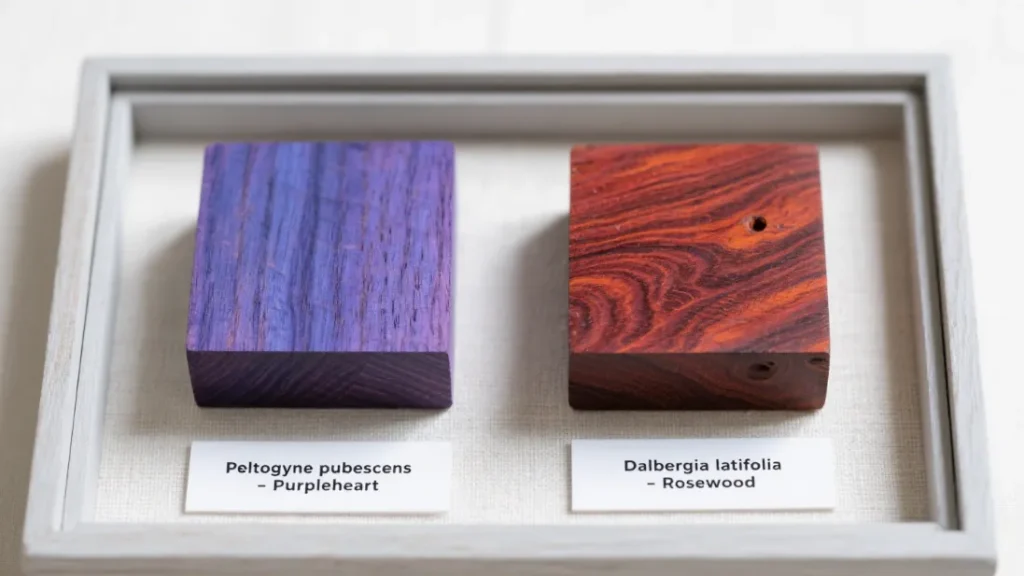
Beyond these examples, the world of exotic woods offers nearly endless possibilities for creating distinctive jewelry boxes. From the golden glow of satinwood to the spicy fragrance of Spanish cedar (excellent for lining), these special materials can elevate a simple jewelry box into an extraordinary treasure that honors the valuables stored within.
In contrast to ornate traditional designs, modern and minimalist wooden jewelry boxes embrace clean lines, innovative forms, and a “less is more” aesthetic. These contemporary designs focus on showcasing the natural beauty of wood while incorporating thoughtful functionality that meets the needs of today’s jewelry collectors.
Modern jewelry box designs often emphasize the material itself, allowing the wood’s natural grain pattern and color to serve as the primary decorative element. This approach celebrates wood as a living material with inherent beauty rather than merely a canvas for elaborate decoration. The result is a timeless quality that complements both contemporary and transitional interior styles.
What makes these designs particularly appealing is their versatility. The clean aesthetic of modern wooden jewelry boxes allows them to blend seamlessly into various home environments, from urban apartments to minimalist homes to eclectic spaces seeking a grounding element. Their restrained design language also ensures they won’t compete visually with the jewelry pieces they contain.
The floating lid box
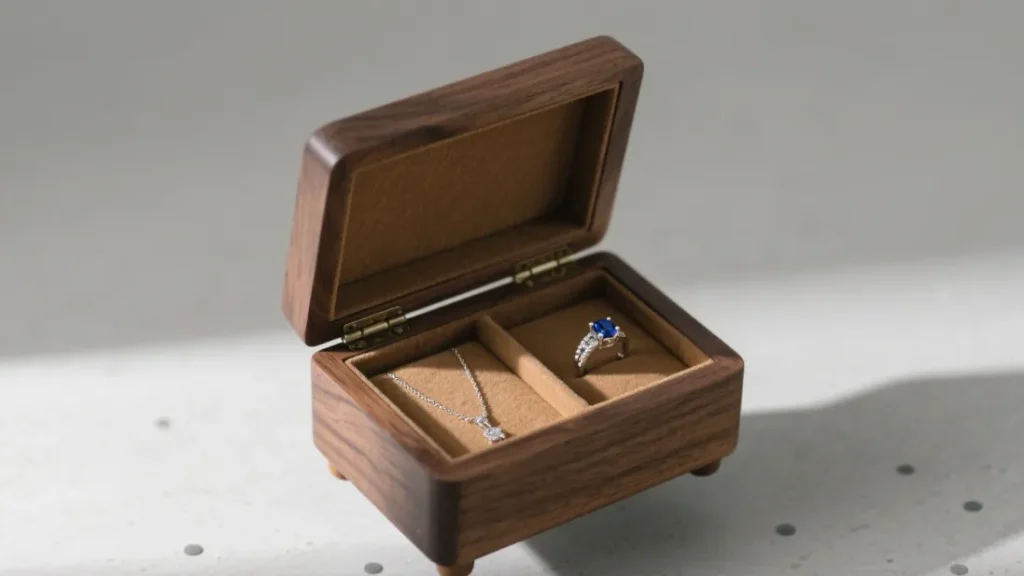
The floating lid box represents a stunning achievement in modern jewelry box design. Unlike traditional hinged lids, these innovative containers feature a top that appears to hover slightly above the base when closed. This visual lightness is typically achieved through recessed edges or cleverly concealed supports. When opened, the lid may slide horizontally or lift entirely off, creating a dramatic reveal of the treasures within. The clean break between components emphasizes precise craftsmanship and creates a sophisticated, gallery-like presentation.
Geometric pattern inlays offer a contemporary alternative to traditional decorative techniques. Rather than ornate floral motifs or pictorial scenes, modern jewelry boxes often feature abstract geometric patterns created through contrasting wood species. Think bold triangular arrangements, concentric squares, or asymmetrical compositions that create visual rhythm across the lid or sides. These patterns feel fresh and artistic while still showcasing traditional woodworking skills like precise cutting and fitting of contrasting woods.
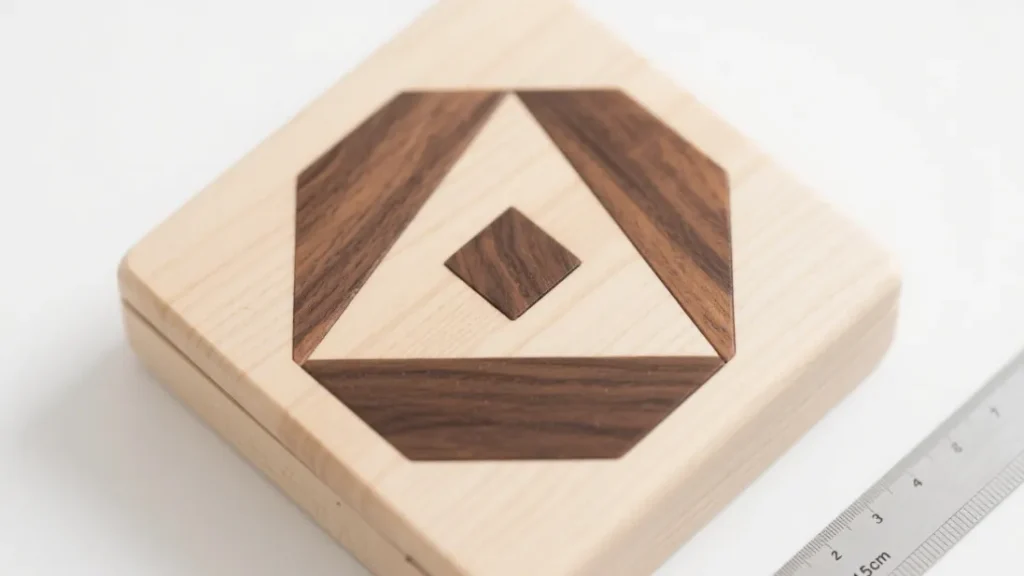
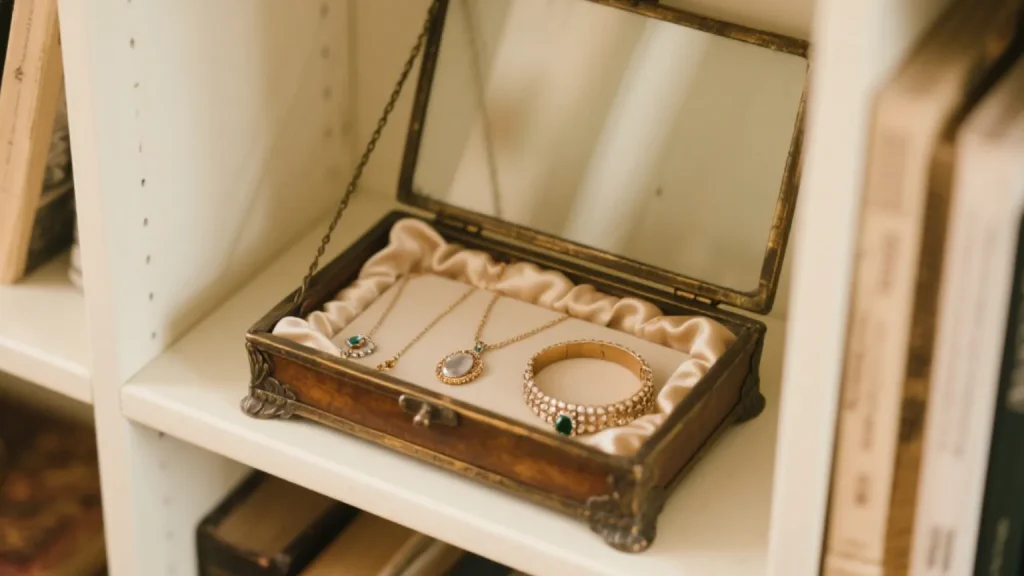
The hidden compartment design has evolved significantly in modern jewelry boxes. While secret compartments have existed for centuries, contemporary approaches integrate them seamlessly into clean, architectural forms. False bottoms, magnetic catches, and push-to-open mechanisms conceal valuable items without visible hardware or obvious clues. Some designs incorporate multiple layers of concealment, requiring a specific sequence of actions to access all compartments—providing both security and an interactive element.
Cantilevered multi-level boxes represent engineering marvels disguised as simple containers. When closed, these boxes appear as straightforward geometric forms—perhaps a cube or rectangular prism. Upon opening, however, they reveal a complex arrangement of sliding or pivoting sections that extend outward in surprising ways. This transformation maximizes storage space while creating a sense of discovery and delight. The mechanical aspects of these designs often operate without visible hardware, maintaining clean lines and emphasizing the designer’s ingenuity.
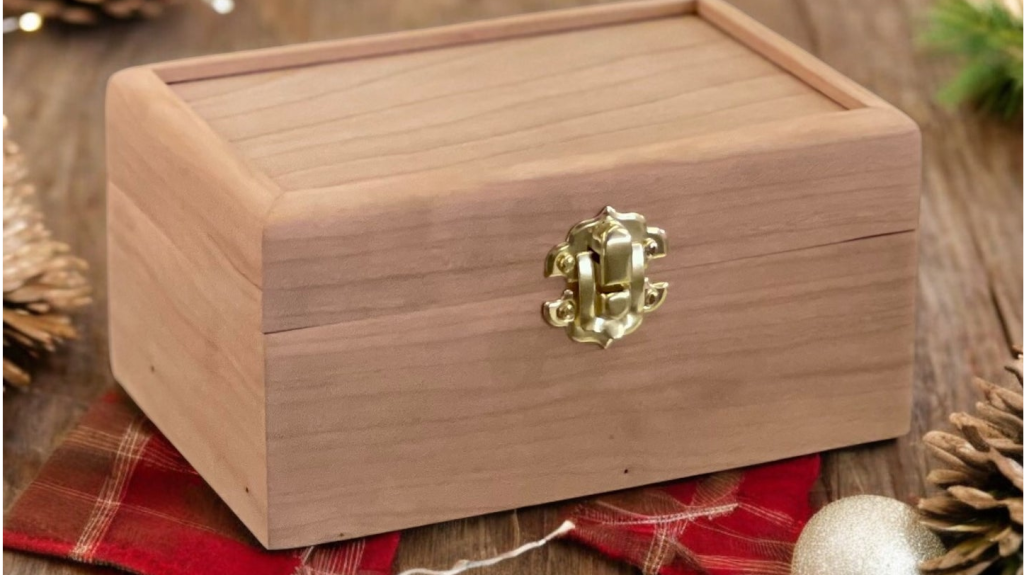
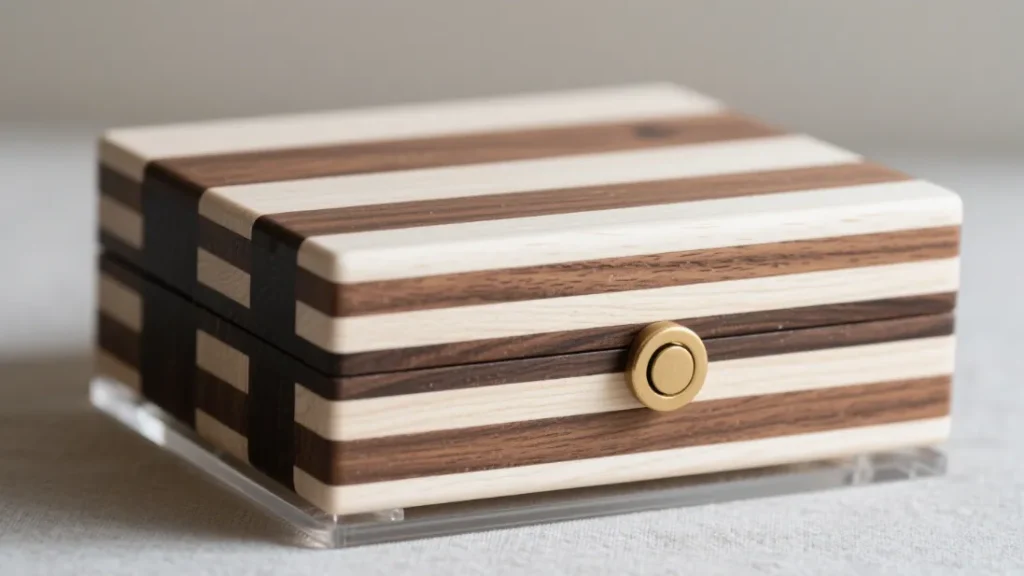
Laminated wood stripe patterns create visually striking modern jewelry boxes through a technique that’s both traditional and contemporary. By bonding thin layers of contrasting woods (typically light species like maple with darker ones like walnut or wenge), craftsmen create dramatic striped patterns that can run horizontally, vertically, or diagonally across the box. This technique allows for precision impossible with natural wood alone, creating perfectly regular bands of color that satisfy our modern appreciation for ordered patterns while maintaining the warmth of natural materials.
The single wood slab box
The single wood slab box epitomizes minimalist design philosophy. Created from one continuous piece of exceptional wood, these boxes eliminate visible joinery in favor of celebrating the material itself. The selection of wood becomes paramount—often featuring spectacular figure patterns, unusual grain orientation, or rare species with distinctive coloration. The exterior might maintain the natural edge of the wood (live edge) or be precisely milled into a perfect geometric form. Either approach requires exceptional material and craftsmanship to achieve seeming simplicity.
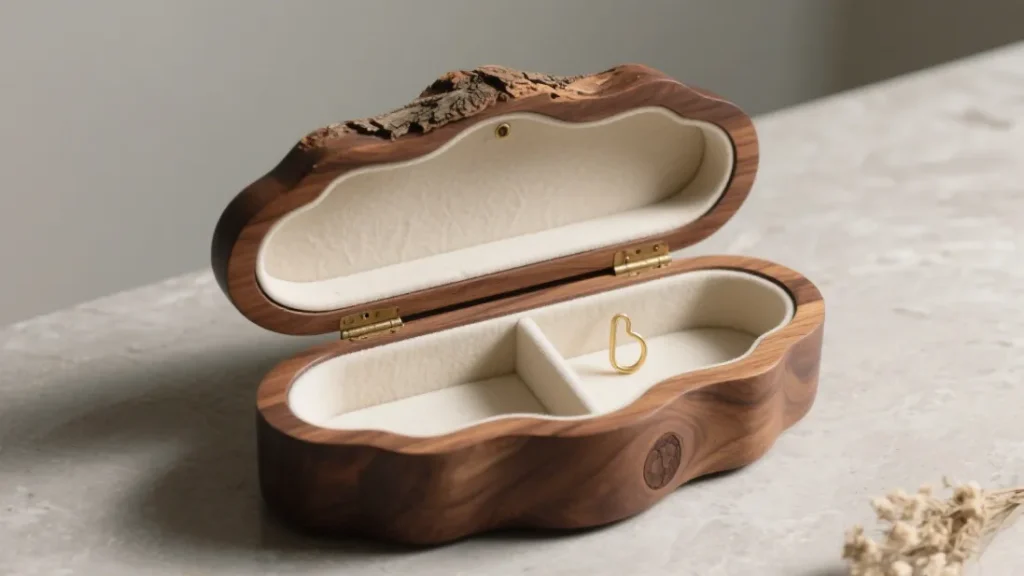
Floating drawer boxes
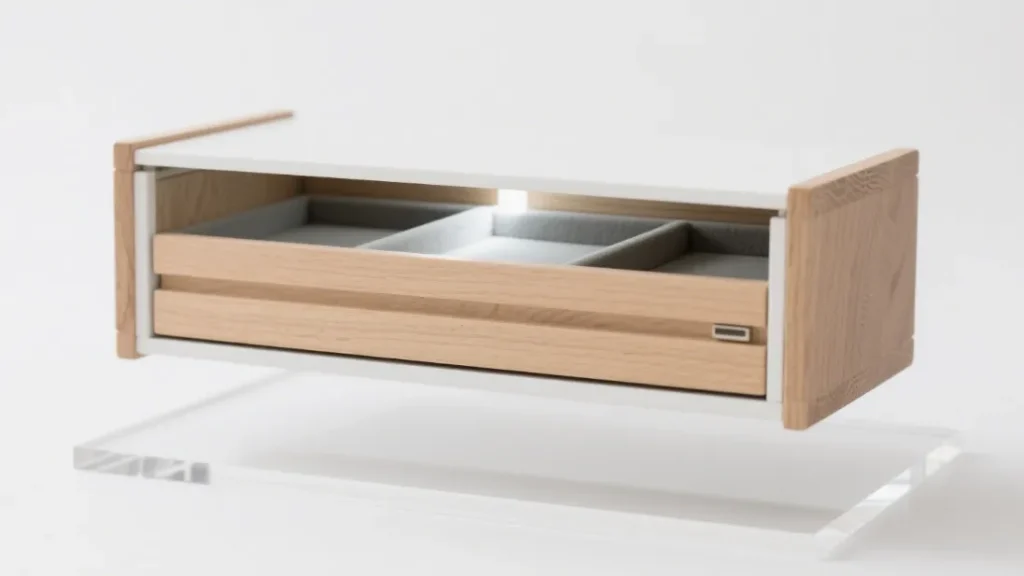
Floating drawer boxes create visual intrigue through clever engineering. These designs feature drawers that appear to float within a frame, with no visible supports or hardware. The clean lines and apparent defiance of gravity make these pieces particularly striking. Achieving this effect requires precise tolerances and innovative construction techniques, often utilizing hidden wooden slides or custom metal hardware concealed within the structure. The result combines minimalist aesthetics with subtle mechanical sophistication.
Bent wood designs
Bent wood designs showcase both technical skill and organic forms. Using steam-bending or lamination techniques, craftsmen create jewelry boxes with gracefully curved sides formed from single continuous pieces of wood. This approach eliminates corner joints entirely, resulting in fluid forms that feel both modern and natural. The gentle curves create a soft, approachable aesthetic that contrasts beautifully with the geometric precision of other minimalist designs. These boxes often feature simple closure methods, such as magnets or precise friction fits, to maintain the seamless exterior.
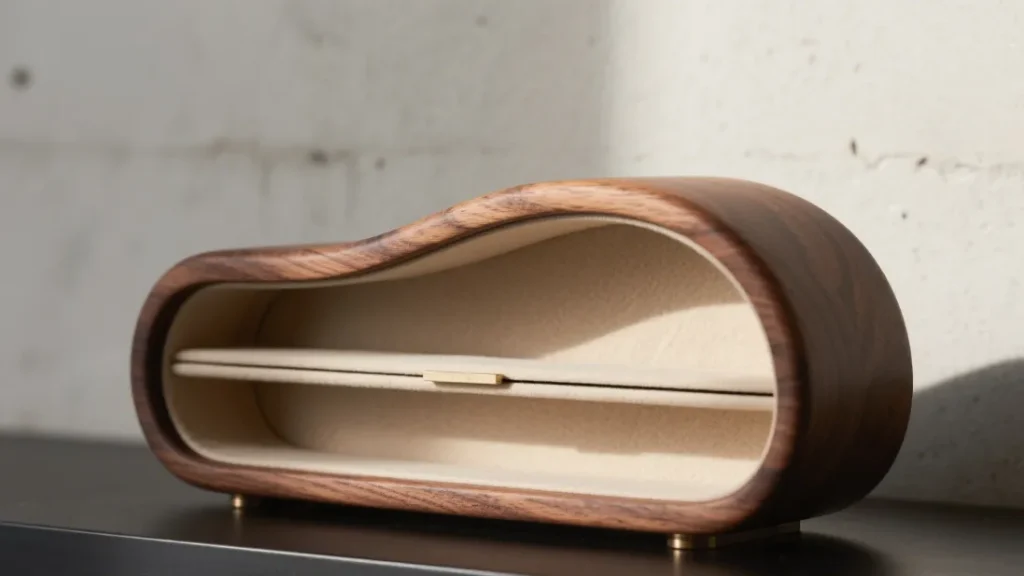
The invisible hinge box
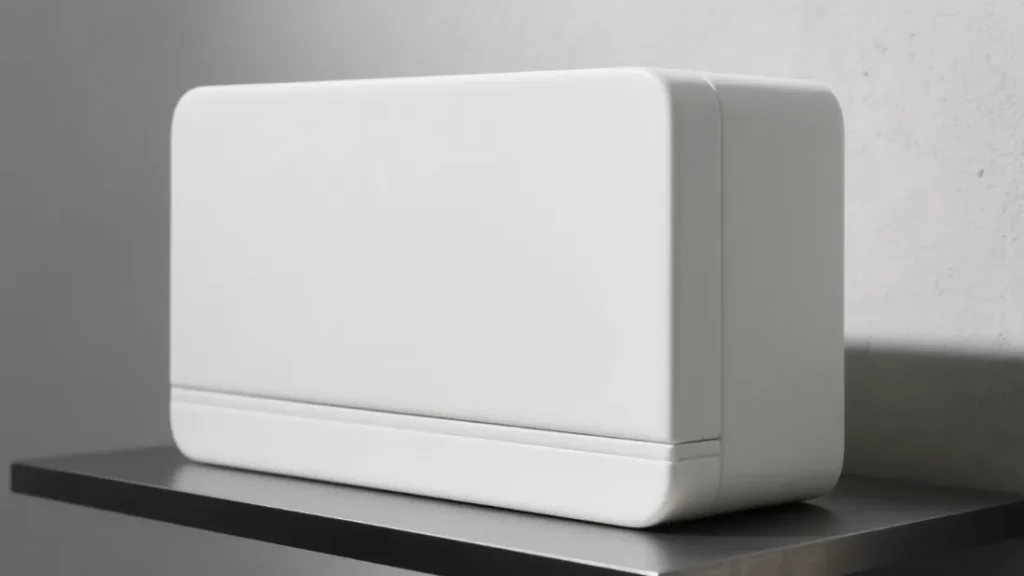
The invisible hinge box represents the pinnacle of minimalist hardware integration. Rather than traditional metal hinges, these designs utilize wooden integrated hinges, precisely fitted wooden pins, or specialized concealed hardware that allows the lid to open smoothly while maintaining clean, uninterrupted exterior surfaces. When closed, these boxes present as perfect forms with no visible mechanisms—the wooden equivalent of a seamless iPhone. The technical challenges of creating such pieces make them particularly valued by collectors who appreciate both design restraint and technical virtuosity.
Japanese-inspired minimal boxes
Japanese-inspired minimal boxes draw on centuries of Eastern woodworking tradition while feeling thoroughly contemporary. These designs embrace principles like asymmetrical balance, careful proportion, and the celebration of natural wood characteristics. Many feature perfectly fitted wooden joinery techniques like finger joints or dovetails, executed with such precision that they become decorative elements in their own right. The influence of Japanese aesthetics often extends to the interior organization as well, with thoughtfully designed compartments that bring order and intention to the storage of precious items.
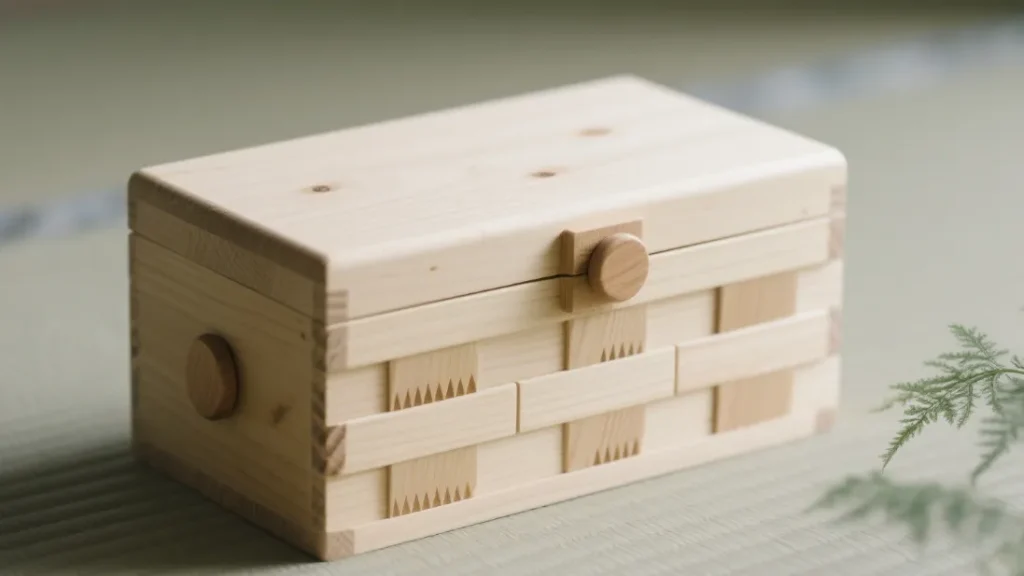
Modern and minimalist jewelry boxes prove that simplicity is not the same as plainness. By reducing designs to their essential elements, focusing on premium materials, and executing with flawless craftsmanship, these contemporary wooden boxes achieve a sophisticated elegance that complements today’s jewelry collections and living spaces. Their clean forms create a perfect backdrop for showcasing the inherent beauty of wood itself, demonstrating that sometimes the most compelling design statement is one of restraint.
In an age of mass-produced items and digital experiences, rustic and vintage-inspired wooden jewelry boxes offer a refreshing connection to tradition, craftsmanship, and natural materials. These designs celebrate imperfections, honor historical styles, and bring a sense of warmth and character that many find irresistible in today’s modern homes.
The appeal of rustic and vintage-inspired jewelry boxes lies in their ability to tell stories through their appearance. Whether featuring weathered wood that shows its history, designs that reference specific historical periods, or construction techniques passed down through generations, these pieces connect us to the past while serving very present needs.
Unlike their sleek modern counterparts, rustic and vintage-style jewelry boxes often embrace visible craftsmanship. Hand-cut joinery, tool marks, and natural wood variations aren’t hidden but highlighted as evidence of the human touch that created them. This authenticity resonates with many who seek more soulful objects in their daily lives.
Live edge wood boxes
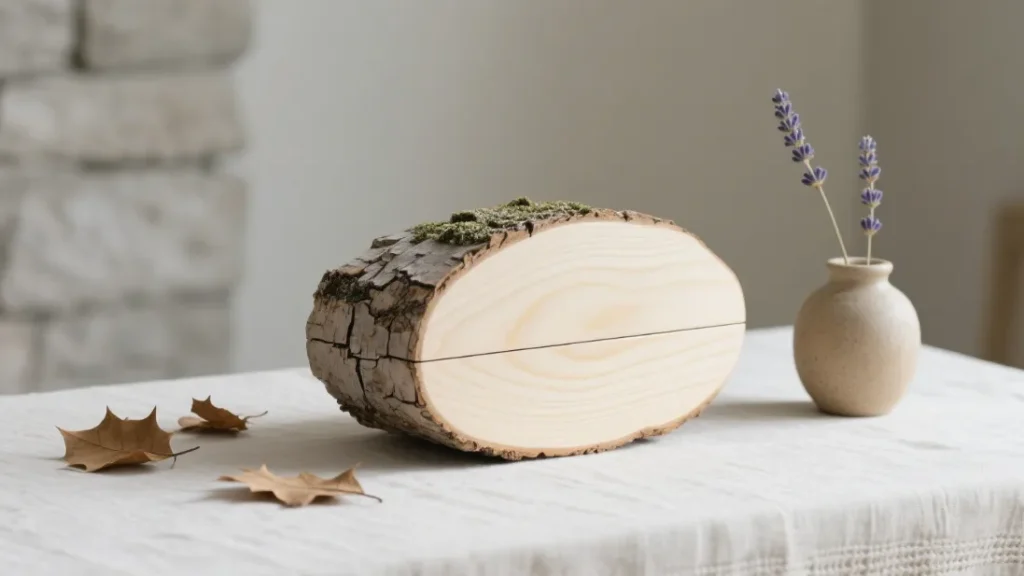
Live edge wood boxes represent perhaps the purest celebration of wood’s natural beauty. These designs incorporate the tree’s original outer edge—complete with bark or the smooth underbark layer—into the box structure, typically as the lid. Each piece is inherently unique, showcasing the tree’s natural contours, grain patterns, and sometimes even small imperfections like knots or mineral streaks. This connection to the raw material creates an organic quality that brings a touch of the forest into your home. Live edge jewelry boxes pair particularly well with rustic or nature-inspired decor.
Reclaimed barn wood designs
Reclaimed barn wood designs give new life to timber with history. Using weathered boards salvaged from old barns, fences, or other agricultural structures, these jewelry boxes carry authentic patina and character impossible to replicate with artificial aging techniques. The wood often features rich coloration developed through decades of sun exposure, along with nail holes, saw marks, and other evidence of its previous life. Beyond their distinctive appearance, these boxes represent sustainable craftsmanship by repurposing materials that might otherwise be discarded.
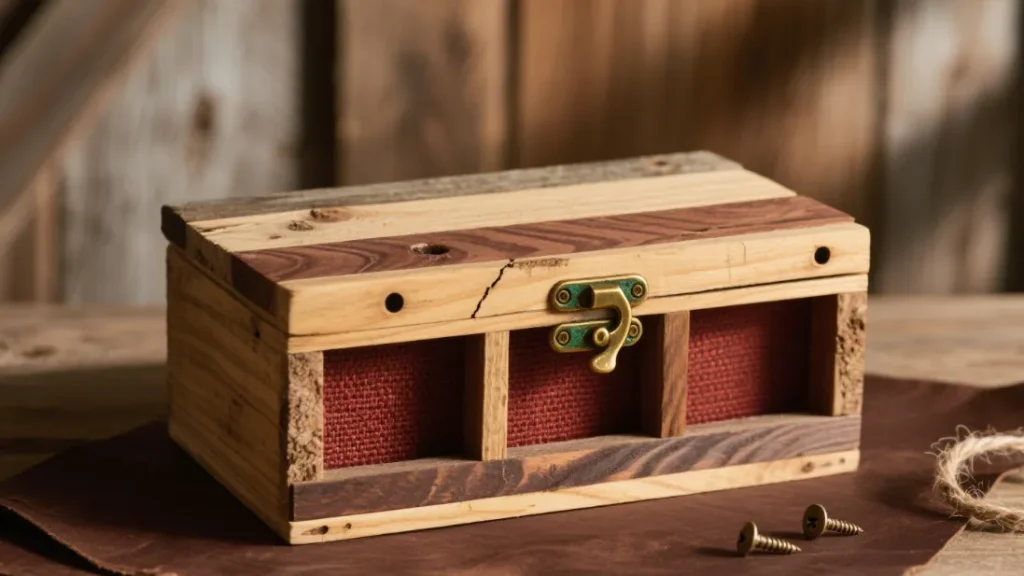
Rustic log boxes
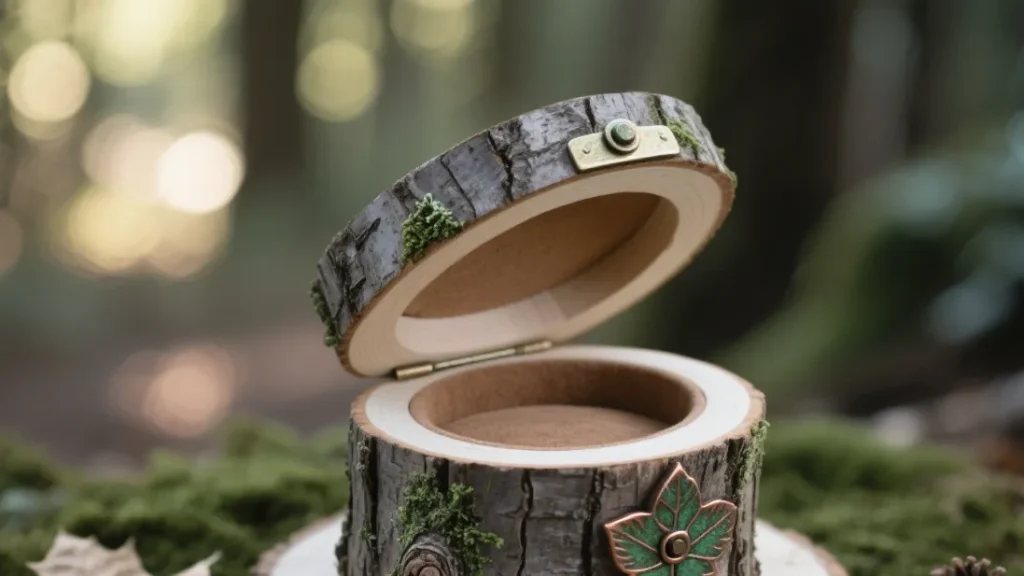
Rustic log boxes maintain the most direct connection to wood’s natural form. Created from hollowed-out sections of tree limbs or trunks with the bark left intact, these containers feel more discovered than manufactured. The interior is typically smoothed and finished for jewelry storage, creating a delightful contrast between the rough exterior and refined inside. Some designs maintain the log’s natural cross-section shape, while others are split and hinged to create a more traditional box form. Either approach results in a one-of-a-kind piece that brings organic texture to your space.
Distressed finish boxes
Distressed finish boxes achieve rustic character through deliberate techniques that mimic the effects of time and use. Craftsmen may employ methods like wire brushing to emphasize grain, strategic sanding to create worn edges, or application of milk paint followed by strategic distressing to reveal layers, simulating how paint naturally wears away over decades. These finishing approaches give new wood an instant sense of history and casual charm, perfect for country cottages, farmhouse-style homes, or any space that values comfort over formality.
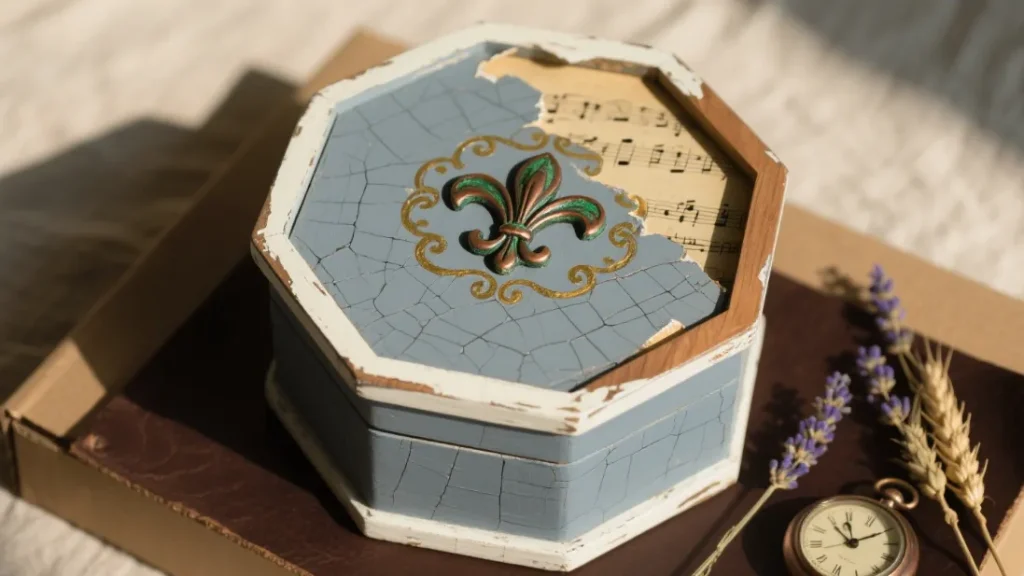
Branch handle designs
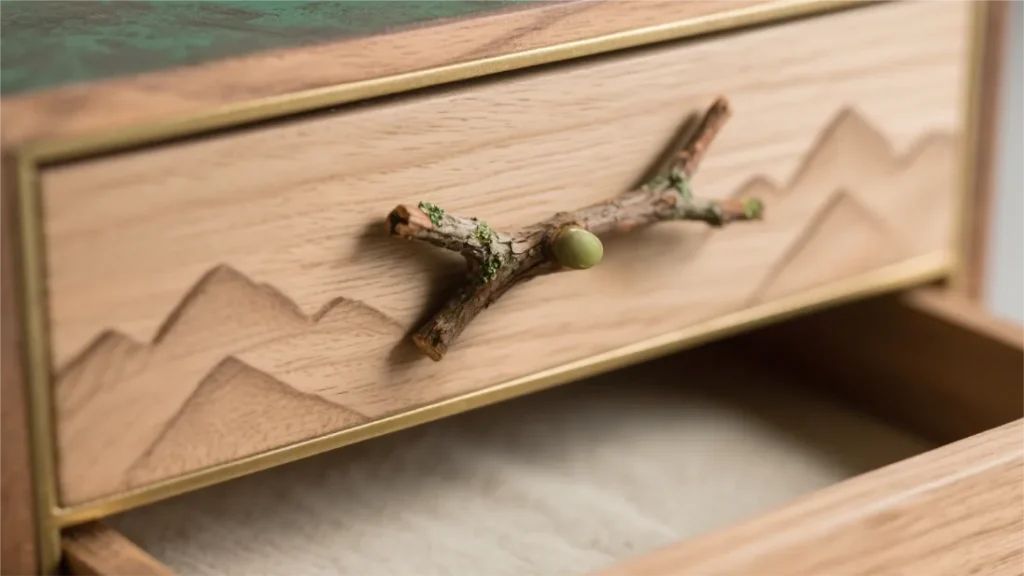
Branch handle designs incorporate actual twigs or small branches as drawer pulls, lid handles, or decorative elements. This unexpected natural detail brings a whimsical woodland quality to jewelry storage. Some artisans select branches with distinctive shapes or interesting bark patterns, while others might use polished sections that reveal beautiful grain. The contrast between the refined box construction and these raw natural elements creates visual interest and tactile pleasure—each time you open the box, you’re literally touching a piece of nature.
Art Deco jewelry boxes
Art Deco jewelry boxes capture the glamour and sophistication of the 1920s and 30s.
These designs typically feature bold geometric patterns, symmetrical compositions, and high-contrast wood combinations that reflect the era’s fascination with modernity and luxury. Chevron patterns, sunburst motifs, and stepped forms (reminiscent of skyscrapers) are common decorative elements. Many Art Deco-inspired boxes incorporate materials like mother-of-pearl, brass inlays, or black lacquer accents to enhance their dramatic visual impact, creating perfect storage for vintage or contemporary jewelry with bold, graphic appeal.
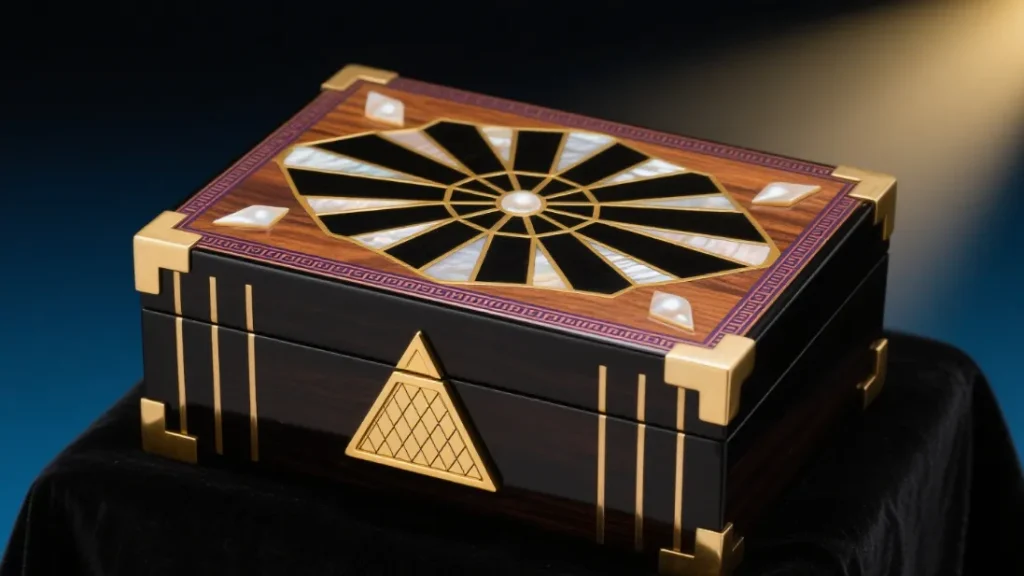
Mid-Century Modern boxes
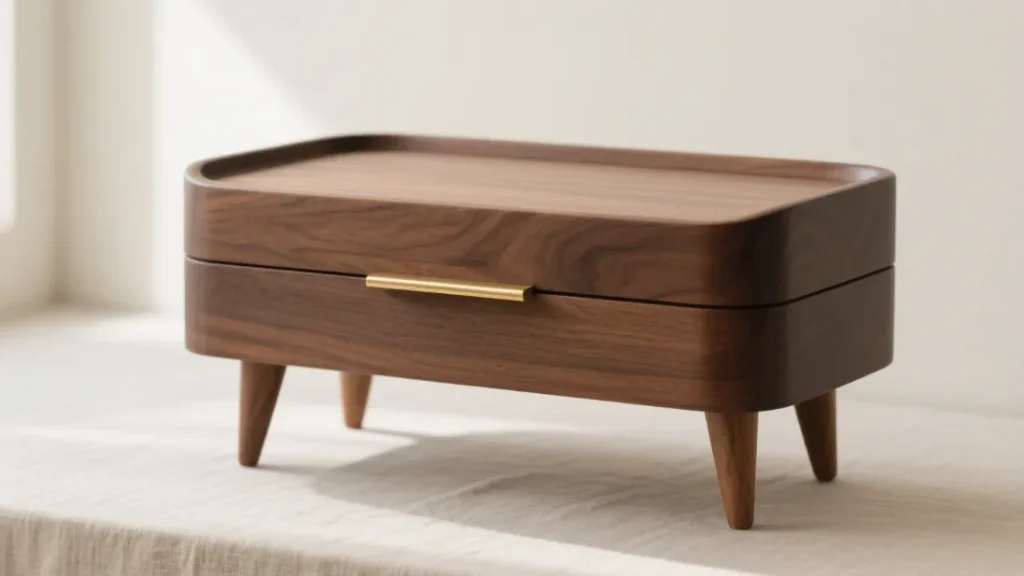
Mid-Century Modern boxes draw inspiration from the clean lines and organic curves popular from the 1940s through the 1960s. Characterized by tapered legs, gentle organic curves, and minimal ornamentation, these designs feel both vintage and timeless. Teak, walnut, and rosewood were favorites of mid-century designers and remain excellent choices for jewelry boxes in this style. These boxes often feature clever functional elements like pivoting compartments or specialized storage areas, reflecting the period’s emphasis on marrying form with innovative function.
Shaker-style simplicity
Shaker-style simplicity offers a vintage aesthetic rooted in the religious community known for exceptional craftsmanship and deliberate design. These jewelry boxes feature clean lines, minimal ornamentation, and perfect proportions, with any decorative elements serving a functional purpose. Traditional Shaker oval boxes (adapted to jewelry storage) feature thin bent wood sides secured with small wooden pins or “fingers,” creating distinctive and recognizable containers. The Shaker philosophy that beauty emerges from purpose rather than decoration produces jewelry boxes with a quiet elegance that has remained relevant for over two centuries.

Antiqued mirror box designs
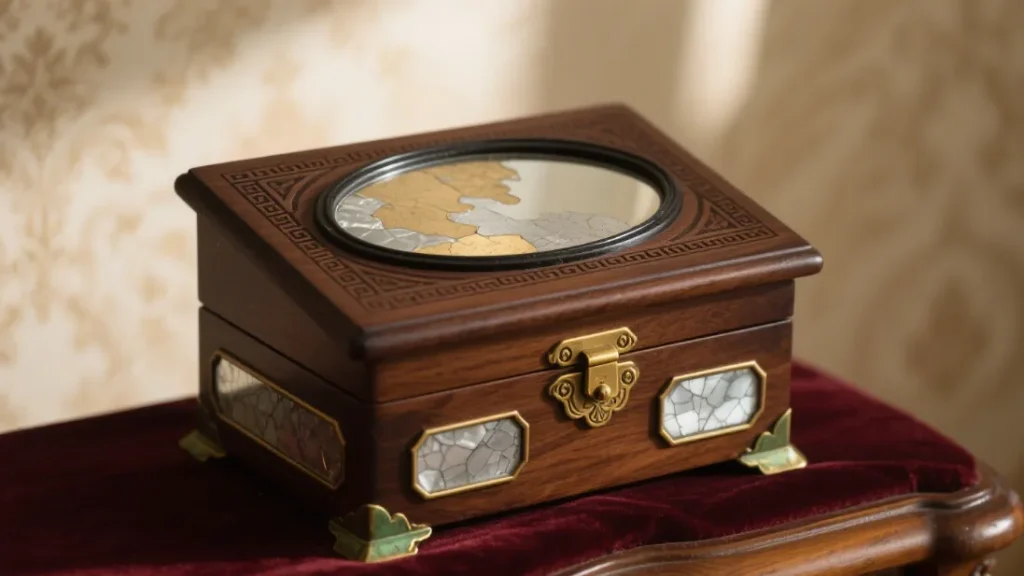
Antiqued mirror box designs combine wood with mirrored glass that has been treated to look aged and slightly cloudy, reminiscent of vintage mirrors. These reflective panels might appear on the lid, sides, or as decorative insets, adding dimension and light-catching properties. The glass may feature deliberate imperfections like spotted backing, faint crackling effects, or a subtle amber tint that suggests decades of aging. This combination of materials creates sophisticated storage with vintage boudoir appeal, perfect for vanity tables or traditional bedroom settings.
Vintage sewing box conversions
Vintage sewing box conversions draw inspiration from the multi-tiered wooden cases once used to organize sewing supplies. These distinctive boxes feature expanding trays that automatically rise when the lid is opened, then nest together when closed. Adapted for jewelry, each tray can be customized with specific compartments for rings, earrings, or necklaces. The mechanical aspect of these boxes adds an interactive quality to the jewelry storage experience, while their association with traditional women’s crafts creates a sentimental connection to generations past.
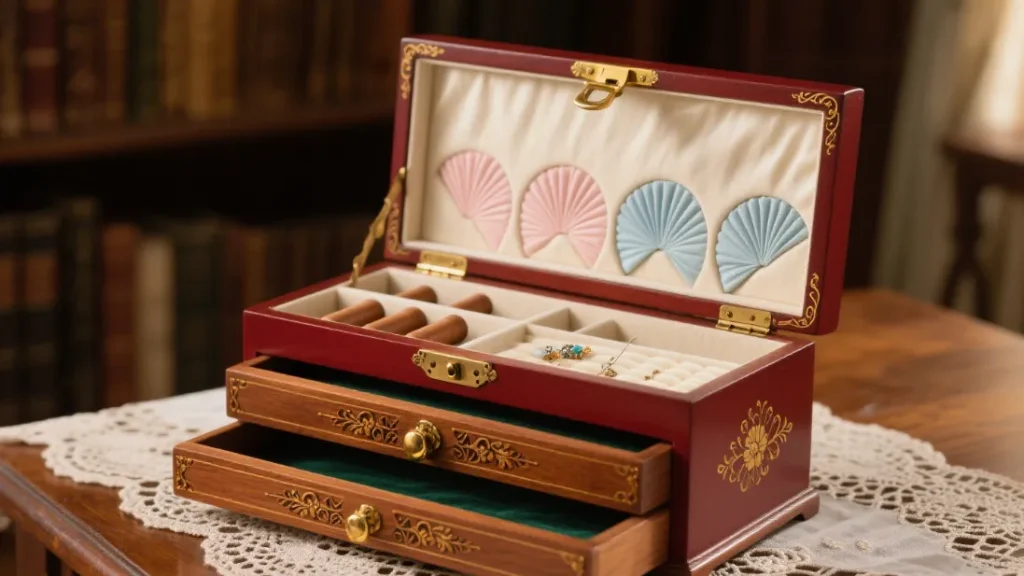
Rustic and vintage-inspired wooden jewelry boxes demonstrate how looking to the past can create pieces perfectly suited for today’s needs. Their distinctive character, authentic materials, and connection to craft traditions make them much more than simple storage—they become meaningful objects that enhance both your jewelry collection and your living environment. Whether you prefer the organic imperfection of rustic designs or the historical refinement of vintage styles, these boxes offer character and charm impossible to find in mass-produced alternatives.
For those who view jewelry storage as an extension of their collection rather than merely a functional necessity, luxury wooden jewelry boxes represent the pinnacle of craftsmanship and design. These high-end pieces transcend ordinary storage to become functional art objects worthy of the treasures they protect.
This philosophy of presentation extends beyond the box itself into the broader world of high-end presentation. To see how top brands create unforgettable moments, be sure to view our showcase of the top 10 luxury jewelry packaging designs to impress your clients.
What distinguishes truly luxury jewelry boxes is the uncompromising approach to materials, construction, and detail. Master craftsmen select only the finest woods with exceptional figure patterns, often combining them with precious metals, gemstones, or other premium materials. Construction features hand-cut joinery executed with tolerances measured in thousandths of an inch, ensuring perfect operation for generations.
High-end wooden jewelry boxes typically require hundreds of hours of skilled labor to complete. This investment of time allows for details impossible in mass production: hand-carved embellishments, complex inlay patterns, custom-fitted interiors, and innovative mechanical features. The result is a one-of-a-kind creation that balances artistry with functionality.
Exotic wood mosaic designs
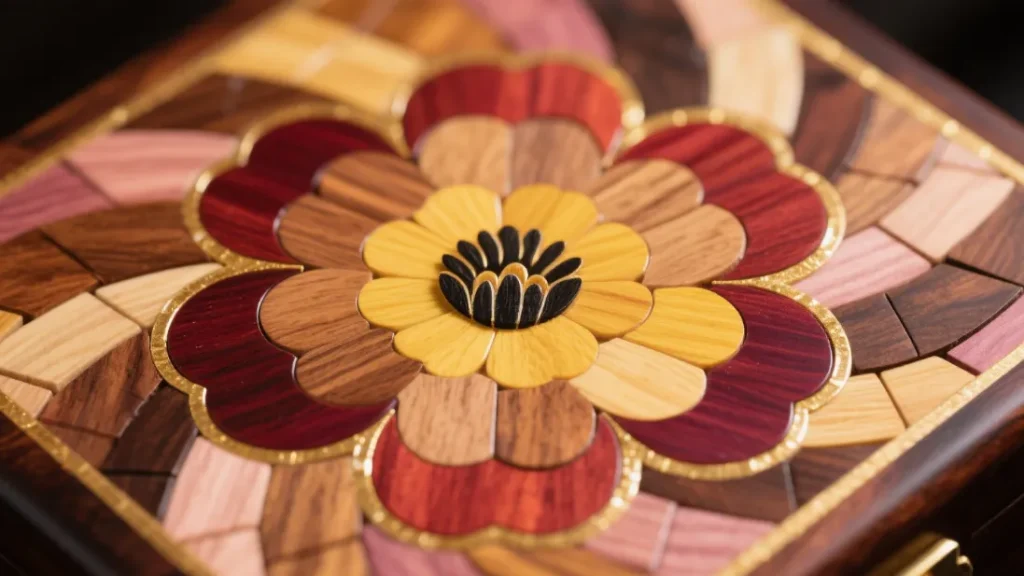
Exotic wood mosaic designs transform jewelry boxes into canvases for remarkable artistry. Master craftsmen carefully select dozens or even hundreds of tiny pieces from various exotic wood species, arranging them to create intricate patterns or pictorial scenes. The natural colors of woods like purpleheart, padauk, yellowheart, ebony, and maple provide a palette ranging from deep blacks to vibrant reds and yellows, all without artificial dyes. These mosaics might depict floral arrangements, geometric patterns, landscapes, or abstract designs, requiring precision cutting and fitting comparable to fine marquetry work.
Wood and fine leather combinations
Wood and fine leather combinations marry two of nature’s most luxurious materials. The exterior might feature panels of hand-tooled or embossed leather set into wooden frames, creating textural contrast and tactile interest. Alternatively, the entire exterior might be wood while the interior features hand-stitched leather compartments and trays.
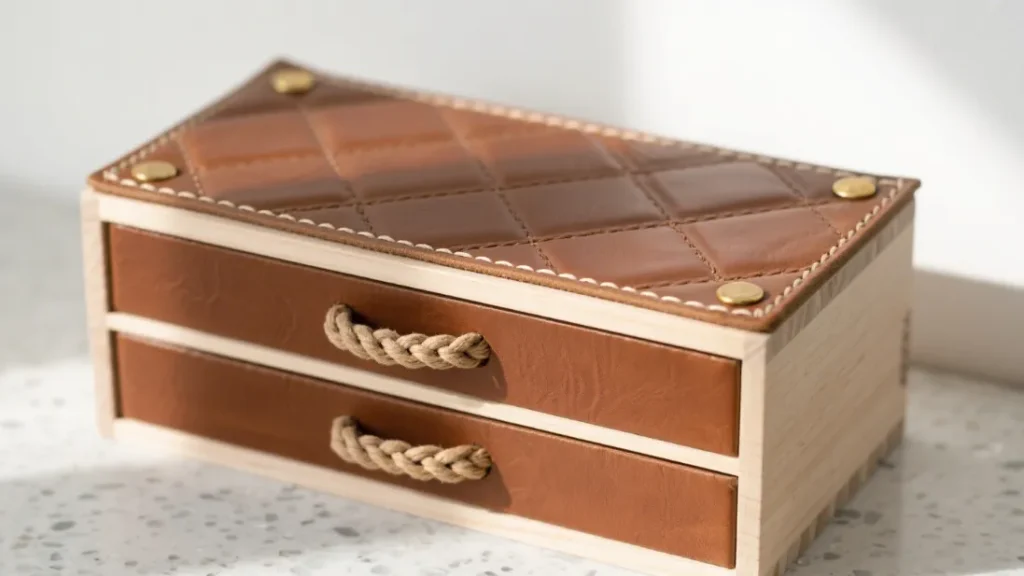
The highest quality implementations use vegetable-tanned leather that develops a beautiful patina over time, complementing the wood’s own aging process. This combination works particularly well for jewelry boxes designed with a masculine aesthetic or those intended to complement traditional interiors.
Precious metal inlay
Precious metal inlay elevates wooden jewelry boxes to extraordinary levels of luxury. Silver, brass, copper, or even gold wire or sheet material is precisely inlaid into channels cut into the wood surface, creating gleaming lines or shapes that catch the light.
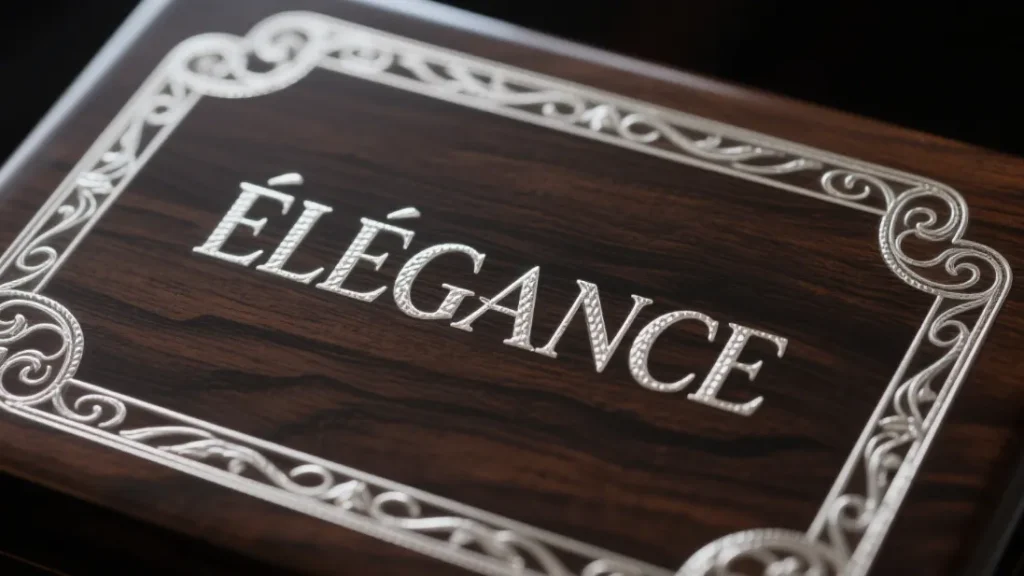
Traditional techniques like mokume-gane (metal laminates that resemble wood grain) might be incorporated for particularly spectacular effects. Beyond their decorative contribution, metal inlays can reinforce corners, protect edges, or serve as personalized monograms. The contrast between the warm wood tones and cool metallic elements creates visual dynamism that draws the eye.
Crystal and wood combinations
Crystal and wood combinations add sparkle and refinement to high-end jewelry boxes.
Crystal elements might appear as knobs, feet, or decorative accents, often custom-cut to complement the box’s design. Some luxury boxes feature crystal panels inset into wooden frames, creating a jewel-like quality appropriate for valuable collections. The reflective properties of crystal catch and scatter light, adding dimension and visual interest. For the ultimate in luxury, some designers incorporate genuine Swarovski crystal elements or vintage crystal components with historical provenance.
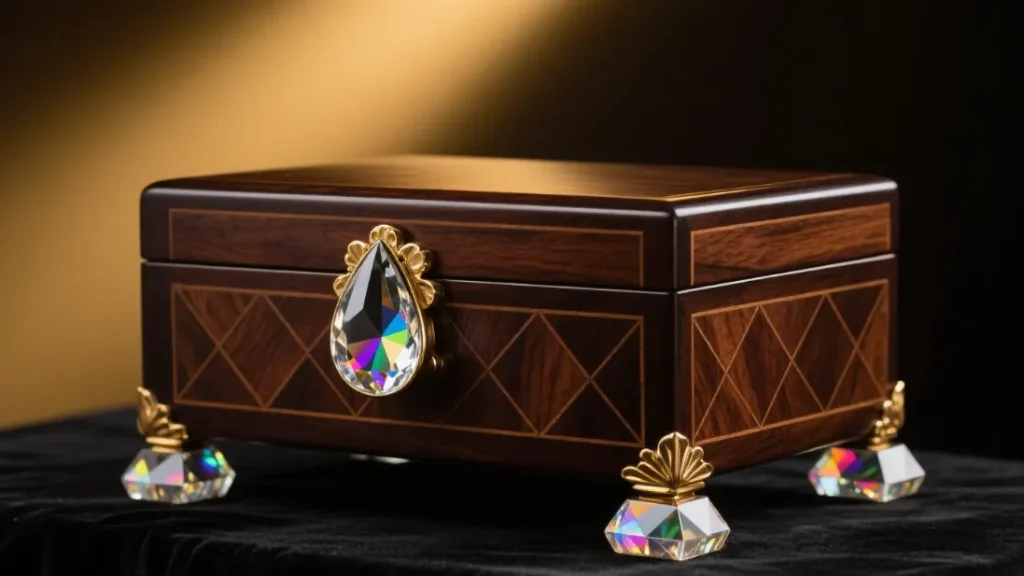
Mother of pearl accented boxes
Mother of pearl accented boxes showcase one of nature’s most magical materials. The iridescent inner lining of certain mollusk shells has been prized for centuries for its color-shifting shimmer and organic patterns.
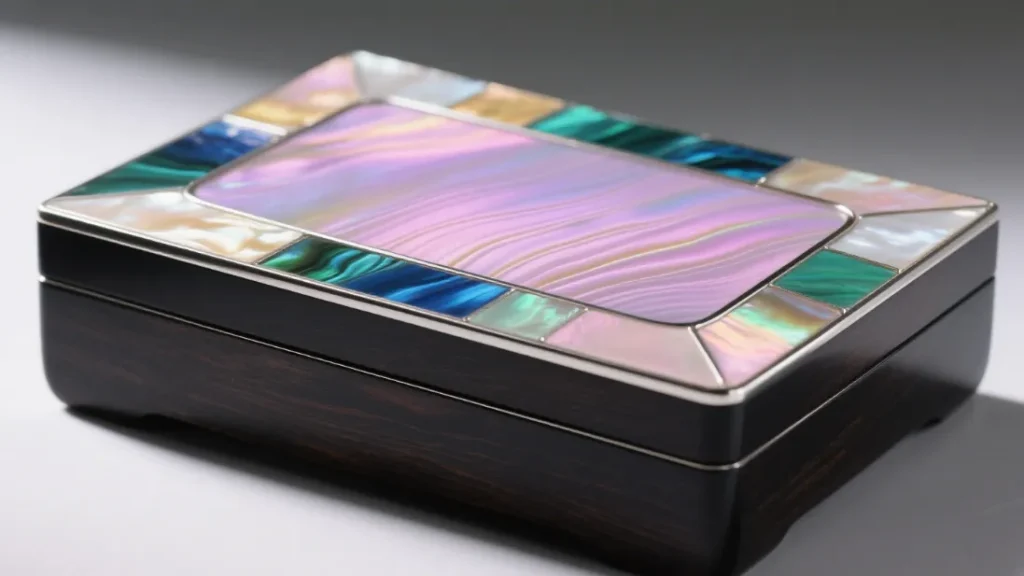
In luxury jewelry boxes, thin slices of mother of pearl might be inlaid to create borders, decorative motifs, or even cover entire surfaces. The material’s subtle rainbow effect complements nearly any wood species while adding a luminous quality that feels particularly appropriate for jewelry storage. Some designs incorporate abalone shell for more vibrant coloration or combine different shell materials for varied effects.
Musical jewelry boxes
Understanding these incredible features is one thing, but learning how they are made is another. For those curious about the professional processes behind these creations, our 2025 latest jewelry box manufacturing guide offers step-by-step expert techniques.
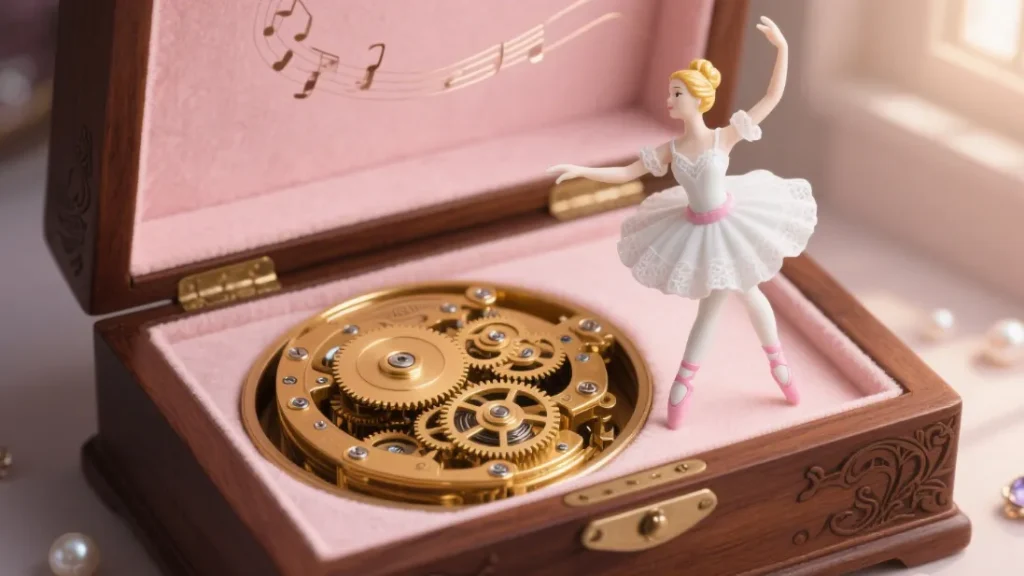
Musical jewelry boxes add an enchanting dimension to the jewelry storage experience. High-end versions feature precision-made Swiss musical movements that play melodies when the lid is opened or when a separate key is wound. The most luxurious examples contain multiple melodies selected via a small lever, or even interchangeable music cylinders allowing customization. The integration of these mechanical elements requires exceptional skill to ensure they don’t compromise the box’s structure or appearance.
The nostalgic quality of a musical jewelry box transforms the simple act of selecting jewelry into a moment of daily pleasure.
Watch winder integration
Watch winder integration represents the ultimate convergence of jewelry and timepiece storage. These sophisticated boxes contain battery-powered or plug-in mechanisms that gently rotate automatic watches to keep them wound when not being worn. The highest quality implementations feature individually programmable winder modules that can be set to the specific requirements of different watch movements.
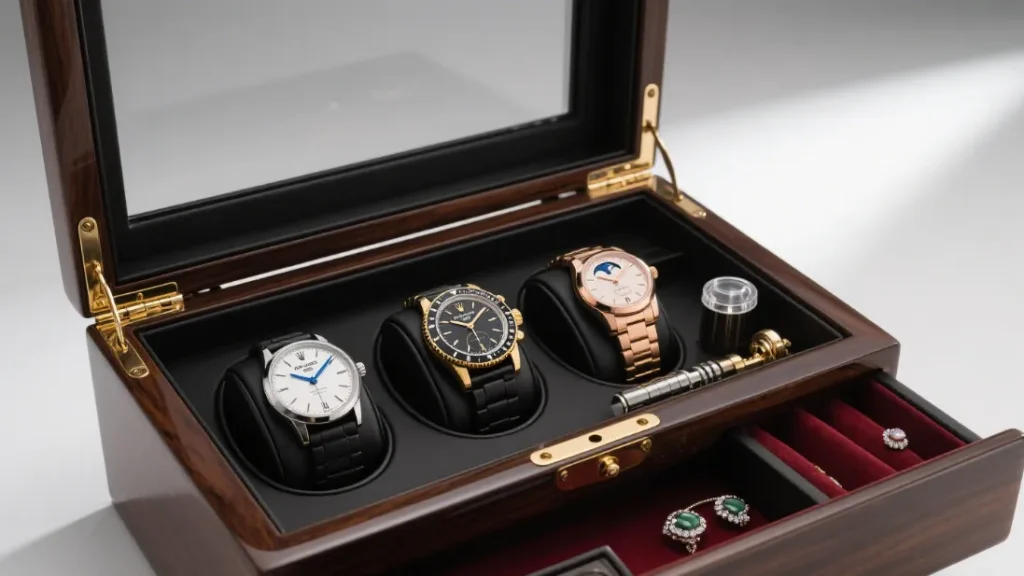
This technological feature is typically housed within a traditionally crafted wooden exterior, creating a pleasing contrast between old-world craftsmanship and modern convenience. For serious watch collectors, these combination boxes eliminate the need for separate storage solutions.
Hand-painted miniature scene jewelry boxes
Hand-painted miniature scene jewelry boxes showcase remarkable artistic talent alongside woodworking skill. Using techniques developed for historical miniature painting, artists create detailed landscapes, portraits, or decorative motifs directly on wood panels incorporated into the box construction.

These paintings are typically protected under multiple layers of clear lacquer to ensure durability without diminishing their visual impact. The finest examples feature scenes painted with such delicacy and precision that they rival museum-quality miniatures, making the container as valuable as the jewelry it holds.
Marquetry masterpieces
Marquetry masterpieces represent perhaps the highest expression of decorative woodworking. This ancient technique involves creating pictures entirely from thin veneers of different wood species, cut and fitted together like puzzle pieces. Master marquetarians might use hundreds of tiny pieces to create landscapes, floral arrangements, geometric designs, or even portraits. Each wood species is selected not only for its color but also for how it will age over time, ensuring the image remains vibrant for generations. The level of detail possible in fine marquetry is astonishing—some artists can create realistic shadows, texture, and dimension using only the natural colors and grain patterns of wood.
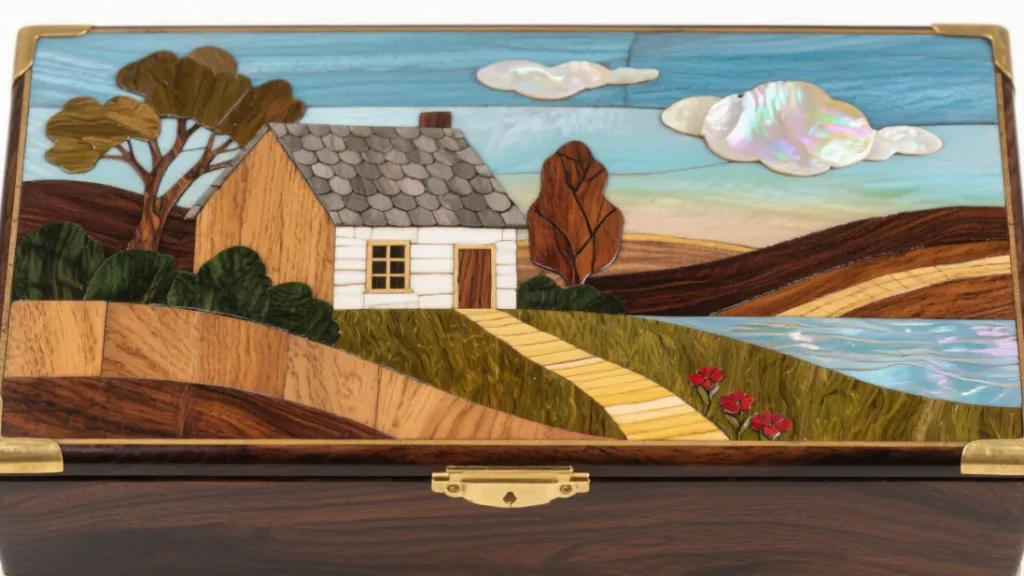
Clockwork mechanism boxes
Clockwork mechanism boxes combine the artistry of fine woodworking with the precision of mechanical engineering. These remarkable containers feature mechanisms that, when triggered, automatically present jewelry in choreographed movements. Drawers might slide out in sequence, platforms might rise, or compartments might rotate into view. The mechanisms are often visible through glass panels or cutaways, allowing appreciation of their brass gears and linkages. The operation typically requires only the turn of a key or press of a hidden button, creating a theatrical presentation experience reminiscent of fine automata or high-end watch complications.
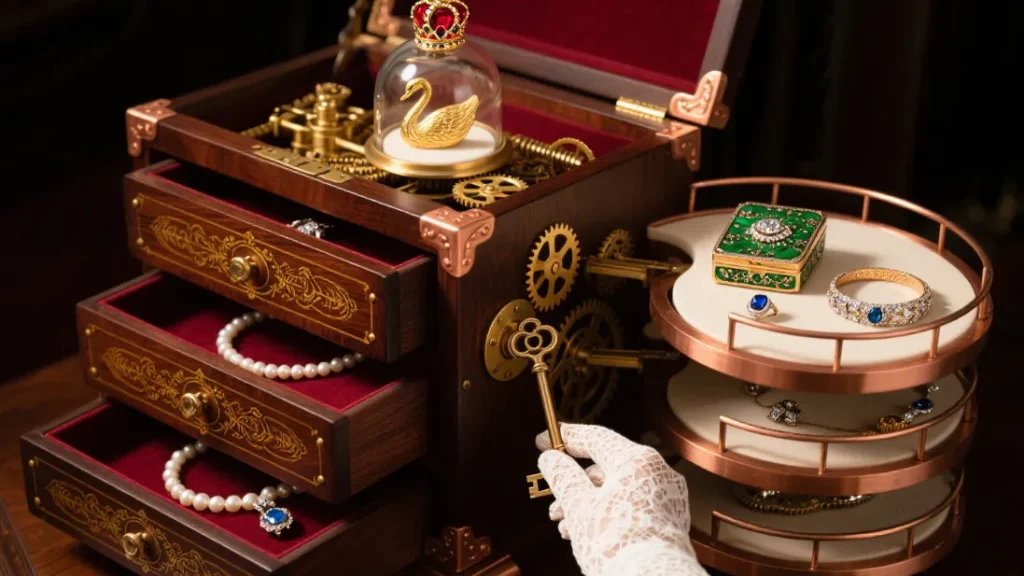
The market for luxury and high-end wooden jewelry boxes caters to those who understand that exceptional quality commands premium prices. These pieces represent significant investments, with prices sometimes reaching into thousands of dollars for the most elaborate custom creations. However, their owners recognize them as both functional objects and works of art that will likely appreciate in value over time, particularly when created by recognized master craftsmen. For those who view their jewelry collection as an important part of their personal expression, these extraordinary wooden jewelry boxes provide storage worthy of their most precious possessions.
While aesthetic appeal matters greatly, the primary purpose of any jewelry box remains proper organization and protection of your valuable collection. Functional designs with thoughtfully planned compartments transform jewelry storage from chaotic to systematic, making your morning routine smoother and extending the life of your precious pieces.
Well-designed compartmentalization addresses the specific needs of different jewelry types. Necklaces require space to hang freely to prevent tangling. Rings need individual slots to avoid scratching. Earrings benefit from specialized storage that keeps pairs together. The best functional jewelry boxes consider these varied requirements and integrate solutions seamlessly into beautiful wooden designs.
Modern jewelry collections often include diverse pieces requiring different storage approaches. A box that works perfectly for someone with mostly rings and earrings might fail completely for someone with numerous bangles or statement necklaces. The most successful functional designs either cater to specific collection types or offer versatile organization that adapts to changing needs.
Ring roll designs
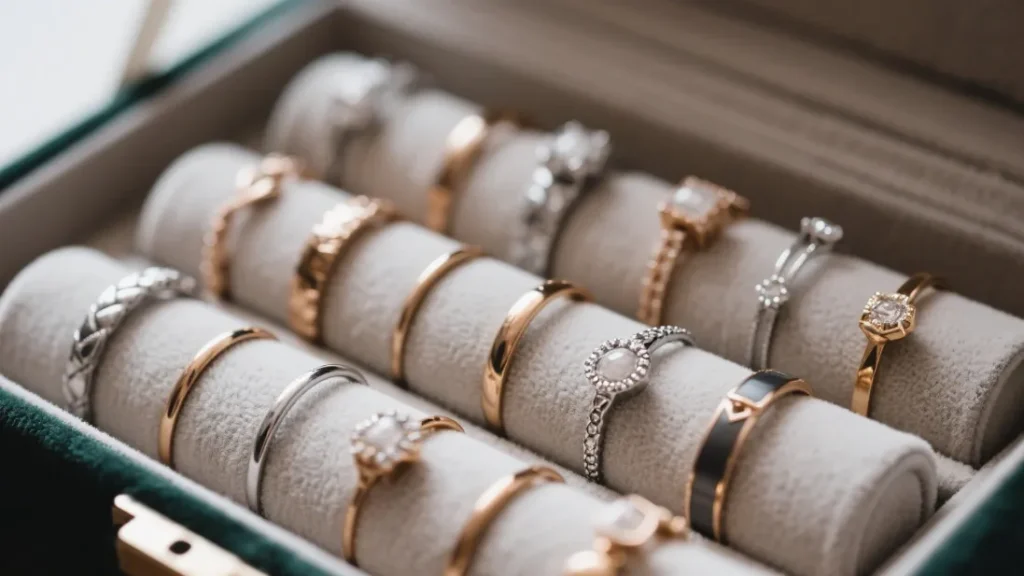
Ring roll designs tackle one of the most common jewelry storage challenges—keeping rings visible, accessible, and protected. These specialized inserts feature cylindrical cushions, typically covered in velvet or ultrasuede, with slight depressions along their length. This simple yet effective design prevents rings from rolling, maintains their circular shape, and allows you to see your entire collection at a glance. High-quality versions use firm but yielding materials that protect rings without putting pressure on settings or stones. Some designs incorporate multiple rolls at different heights, creating a stadium-like arrangement for maximum visibility.
Necklace hanging systems
Necklace hanging systems prevent the frustration of tangled chains and delicate pendants. The most effective designs feature hooks, slots, or specialized compartments that keep each piece separated and fully extended. Vertical hanging systems maximize space efficiency but require sufficient height clearance when the box is opened. Some innovative designs incorporate pull-out panels with multiple hooks, allowing numerous necklaces to be stored in a relatively compact box. For particularly valuable or delicate necklaces, individual padded compartments offer maximum protection against potential damage from other jewelry pieces.
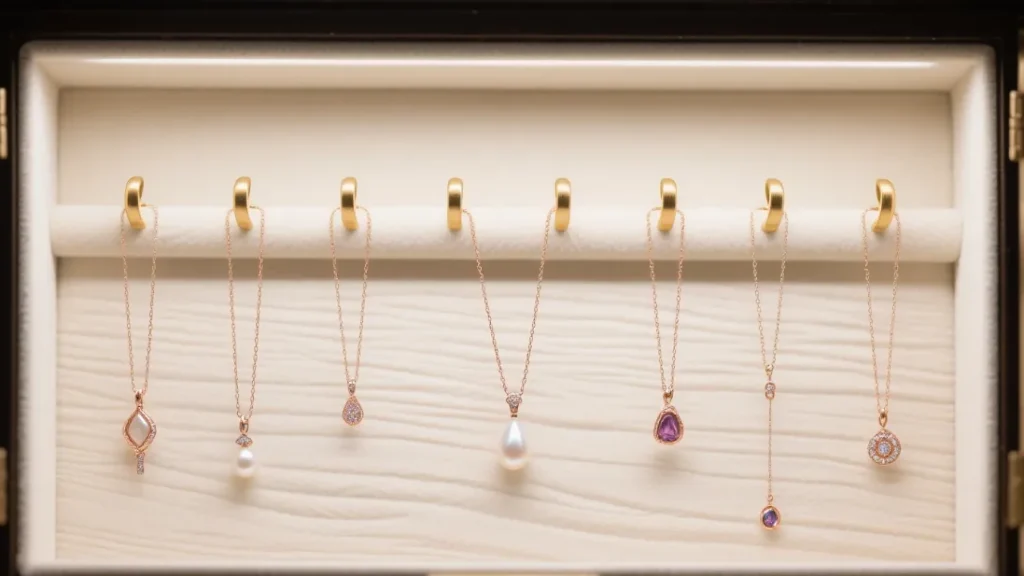
Earring organization grids
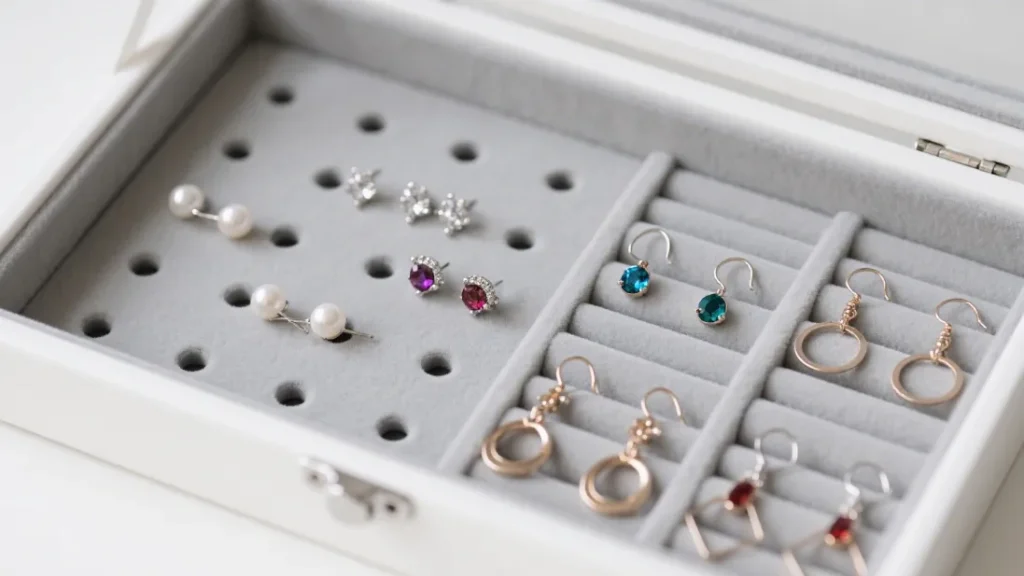
Earring organization grids solve the perpetual problem of keeping pairs together while protecting delicate components. These specialized inserts feature small holes or slots arranged in a grid pattern, allowing post earrings to be secured while dangles hang safely below. Alternative designs include small individual compartments for each pair or fabric-covered panels that allow hook earrings to be attached directly. The best earring storage systems provide visual access to your entire collection while ensuring that matching pairs remain together. For collections that include both stud and dangly styles, combination approaches work best.
Watch box combinations
Watch box combinations cater to collectors who invest in both jewelry and timepieces. These specialized designs typically feature padded cushions that support watches without compressing bracelets or straining leather straps. Individual compartments prevent watches from contacting each other, eliminating the risk of scratches on crystals or case backs. Some designs incorporate removable cushions that can be reconfigured based on collection needs. For those with automatic watches, integration with winding mechanisms ensures timepieces remain ready to wear while simultaneously providing secure storage.
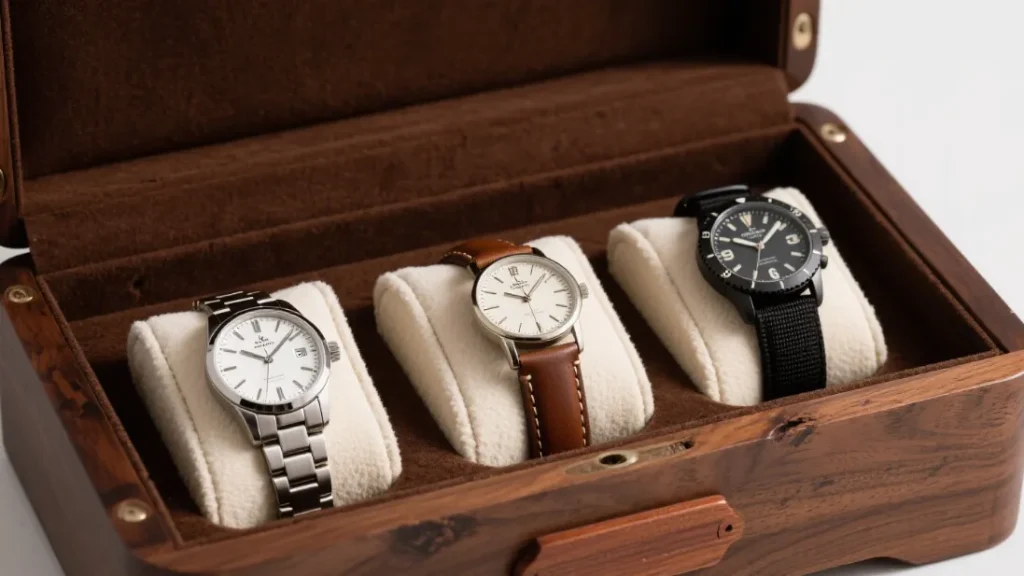
Stackable module systems
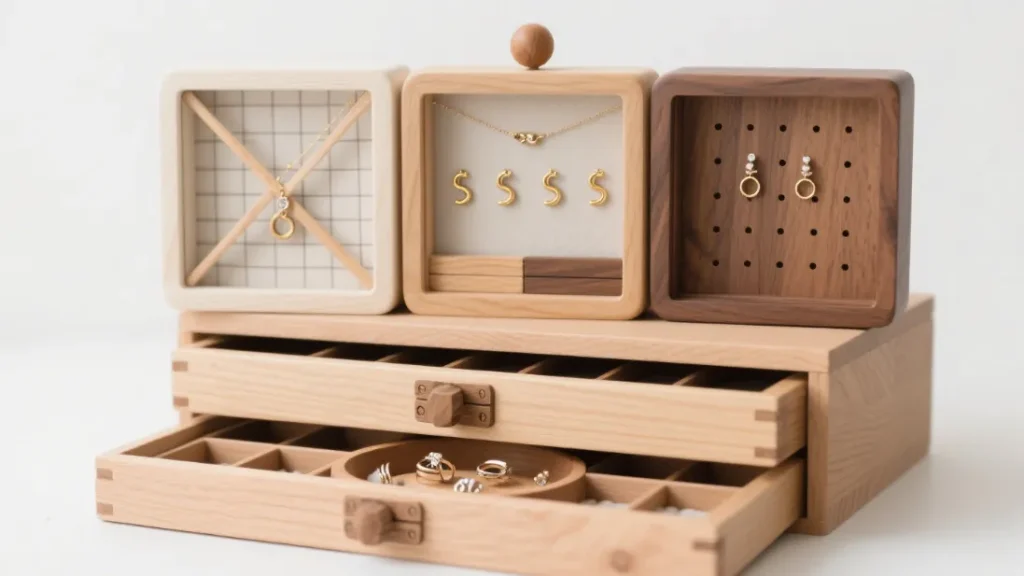
Stackable module systems offer perhaps the most versatile approach to jewelry organization. These designs feature individual trays or boxes that can be stacked securely or used separately as needed. As your collection grows, you can simply add additional modules rather than replacing the entire jewelry box. Each module might be specialized for particular jewelry types—one for rings, another for earrings, a third for bracelets—creating a completely customized storage solution. The most refined versions feature consistent exterior aesthetics while allowing for varied interior configurations, maintaining a cohesive appearance even as the system expands.
Travel jewelry cases

Travel jewelry cases address the specific challenges of transporting valuable pieces safely. These designs typically feature compact dimensions and secure closure mechanisms like locks or robust latches. Interior compartments include specialized features to prevent movement during transit—snap closures for necklace storage, elasticized pockets for securing watches, and padded dividers to prevent items from contacting each other.
The highest quality travel cases balance sufficient protection with reasonable weight and dimensions. Many feature exterior designs that don’t immediately signal their valuable contents, with some even disguised as ordinary boxes or books for additional security during travel.
Vanity table integration
Vanity table integration creates seamless coordination between jewelry storage and the space where many people put on their jewelry. These thoughtfully designed boxes might match the vanity’s finish, incorporate similar hardware, or feature dimensions specifically tailored to fit particular vanity designs. Some function as actual structural elements of the vanity itself, with drawers or compartments built directly into the table.
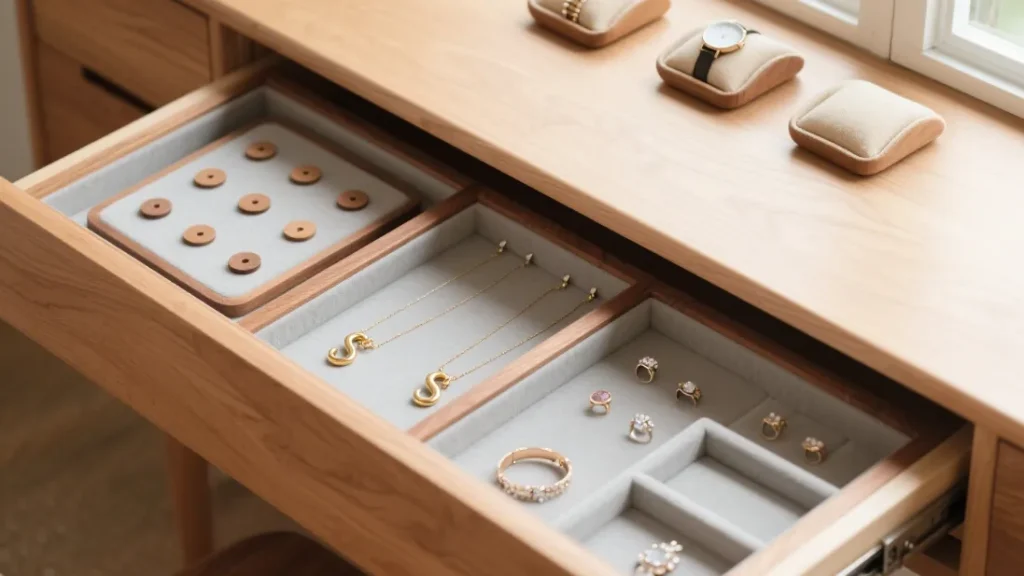
This integration creates both aesthetic harmony and practical convenience—everything needed for your morning routine remains in one dedicated space, eliminating the need to transport jewelry from storage to dressing area.
Standing mirror combination designs
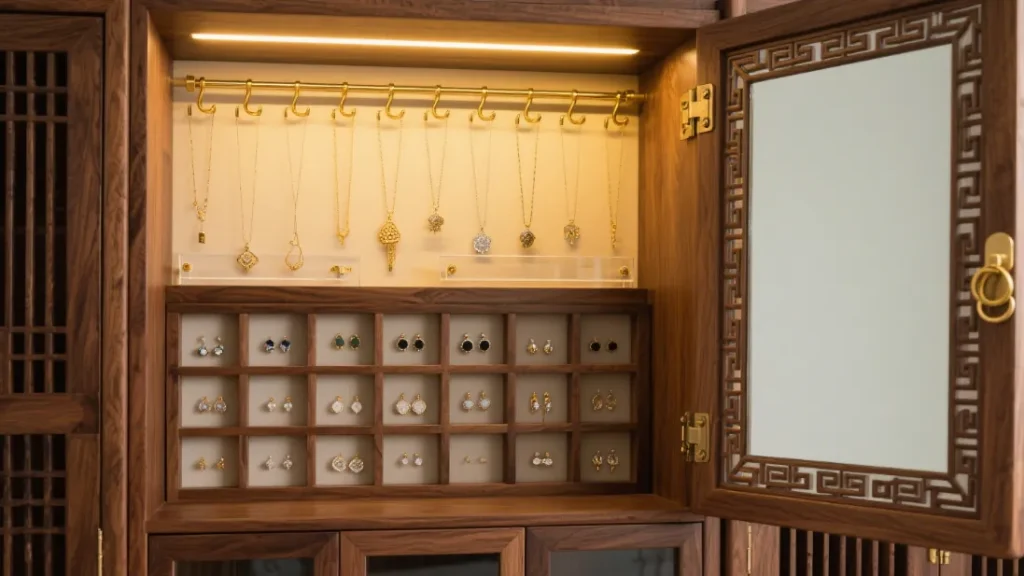
Standing mirror combination designs merge two essential dressing table elements. These innovative pieces feature full-length or vanity-sized mirrors with integrated jewelry storage in the base, behind the mirror, or in side panels that swing out. This combination saves valuable space while creating a practical getting-ready station. Some designs allow the mirror to be angled as needed, with jewelry storage accessible without disturbing the mirror position. Others feature mirror doors that open to reveal the jewelry compartments, providing both security and functionality in one elegant package.
Hidden compartment security boxes
Hidden compartment security boxes offer protection for your most valuable pieces through clever concealment. Unlike obvious safes that announce the presence of valuables, these designs hide high-value items in compartments accessible only to those who know the specific mechanism. Secret compartments might be revealed by pressing specific areas in sequence, removing false bottoms, or operating hidden catches. Some incorporate actual locking mechanisms concealed behind decorative elements or false panels. The most sophisticated examples feature multiple levels of hidden storage with different access methods, allowing you to hide particularly valuable pieces in the most secure sections.
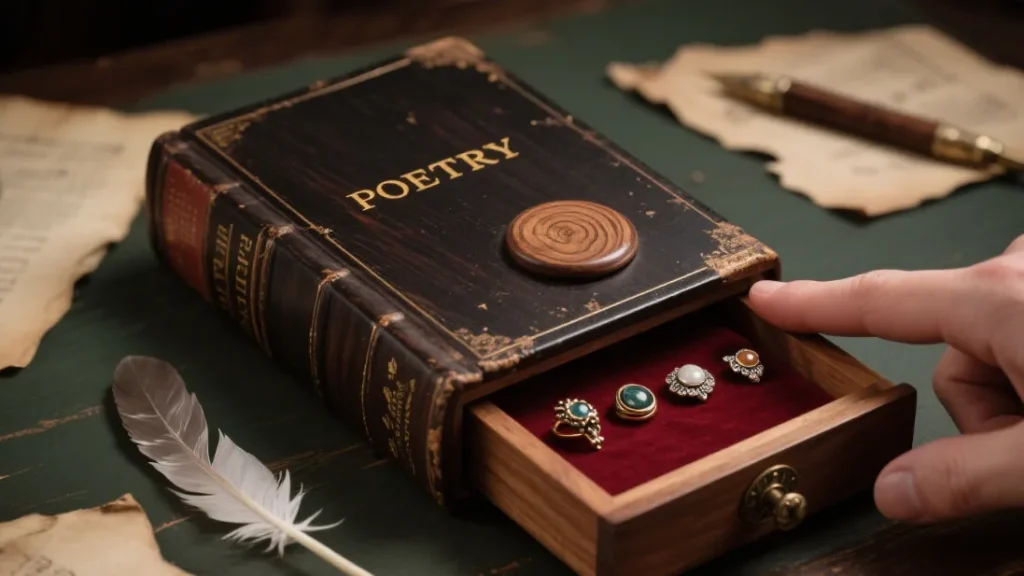
Charging station jewelry box designs
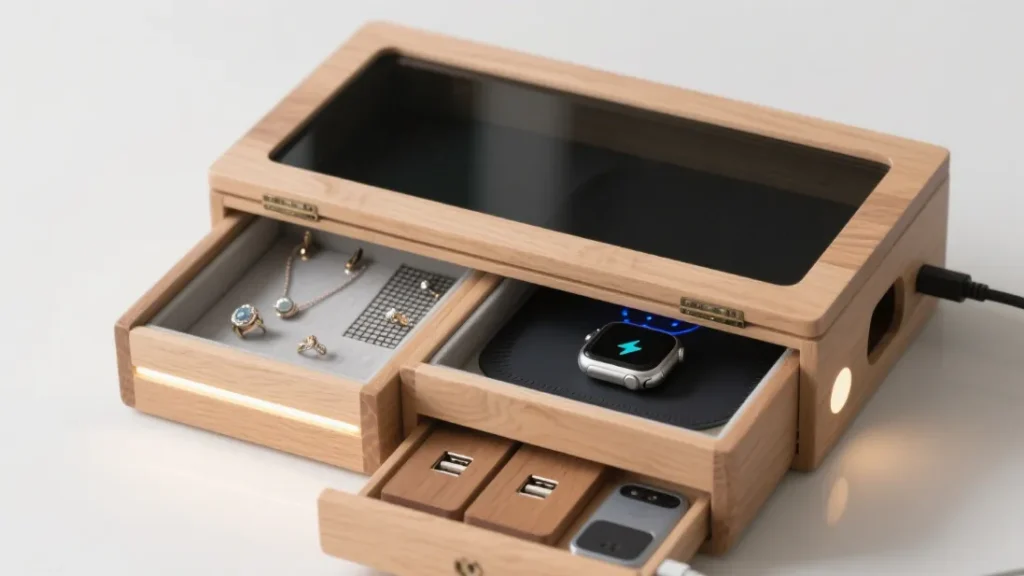
Charging station jewelry box designs address the modern reality that many people’s daily “jewelry” includes electronic devices. These innovative boxes include discrete power cords and USB ports or wireless charging pads integrated into their construction. The charging elements are typically housed in specific compartments separate from traditional jewelry storage to prevent any risk to metal items. This practical combination acknowledges our contemporary habits—the same place where you store your rings and necklaces can also charge your smartwatch or fitness tracker overnight. Some designs even incorporate small drawers specifically sized for earbuds or other tech accessories.
Functional jewelry box designs demonstrate that practicality and beauty need not be opposing forces. The most successful examples incorporate clever organizational features without sacrificing aesthetic appeal. By tailoring storage solutions to the specific requirements of different jewelry types, these thoughtfully compartmentalized boxes enhance both the longevity of your collection and the ease of accessing it. Whether you prefer traditional compartments or innovative multi-function designs, a well-organized wooden jewelry box transforms jewelry storage from a challenge into a pleasure.
Beyond functional storage and traditional designs, wooden jewelry boxes can be canvases for remarkable creativity and artistic expression. These unconventional approaches transform utilitarian containers into conversation pieces that reflect personal style and artistic sensibilities while still serving their practical purpose.
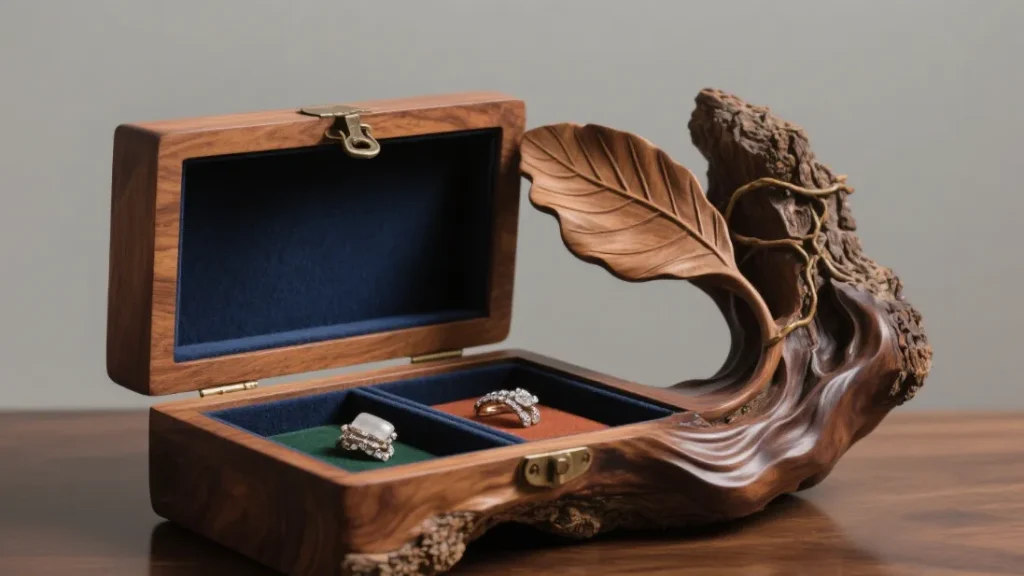
Creative jewelry boxes often blur the boundary between functional object and sculptural art. They challenge our expectations of what a jewelry box should look like while maintaining the essential qualities of protection and organization. For those who view their homes as expressions of individual taste, these artistic designs offer storage solutions that double as decor statements.
What makes these designs particularly compelling is their ability to surprise and delight. Unlike conventional boxes that reveal their purpose immediately, artistic jewelry boxes often incorporate elements of discovery, inviting interaction and exploration. This playful quality adds an emotional dimension to the practical act of jewelry storage.
Abstract form boxes
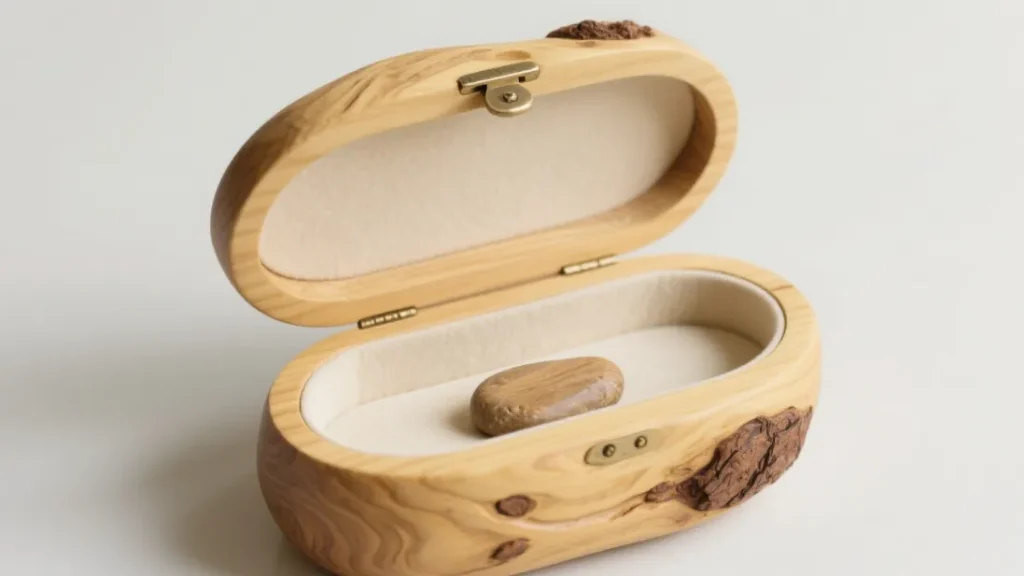
Abstract form boxes break free from traditional rectangular shapes, embracing organic curves, asymmetrical compositions, or geometric innovations. These sculptural pieces might resemble natural formations like river stones, architectural elements, or completely non-representational forms that appeal purely through line, shape, and proportion. The interior typically provides conventional jewelry storage, creating an intriguing contrast between the unconventional exterior and the functional interior. These boxes often become focal points in a room, standing as art objects even when their contents remain hidden.
Tree of life designs
Tree of life designs incorporate one of humanity’s most universal and ancient symbols into jewelry storage. Skilled woodworkers might create this motif through relief carving, where the tree image stands proud from a recessed background, or through inlay work using contrasting wood species. The symbolism of growth, connection, and continuity makes these designs particularly meaningful as containers for jewelry that often carries emotional significance. Some interpretations incorporate actual branch forms as structural elements, while others use the tree imagery in more stylized or abstract ways.
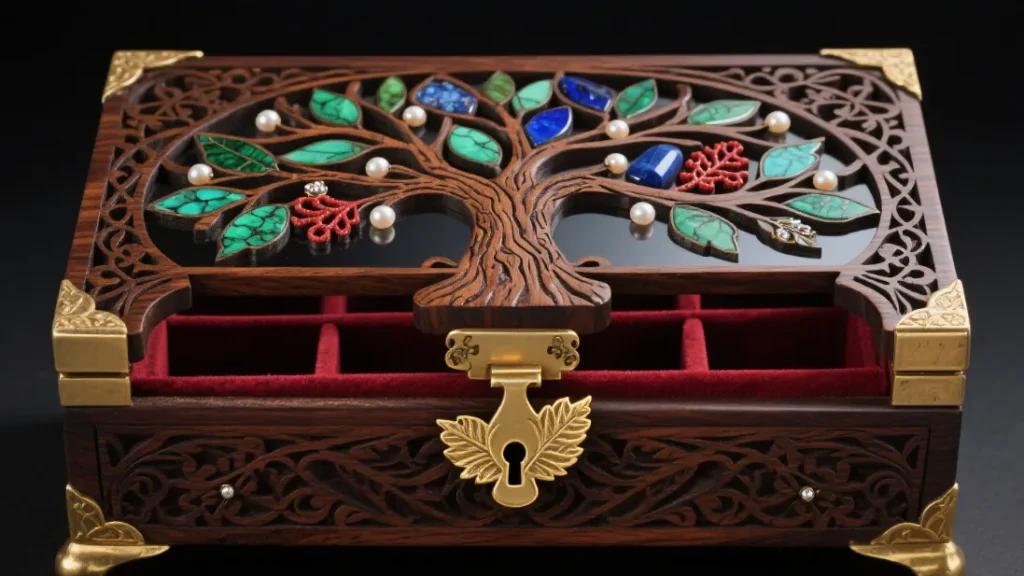
Book-shaped jewelry boxes
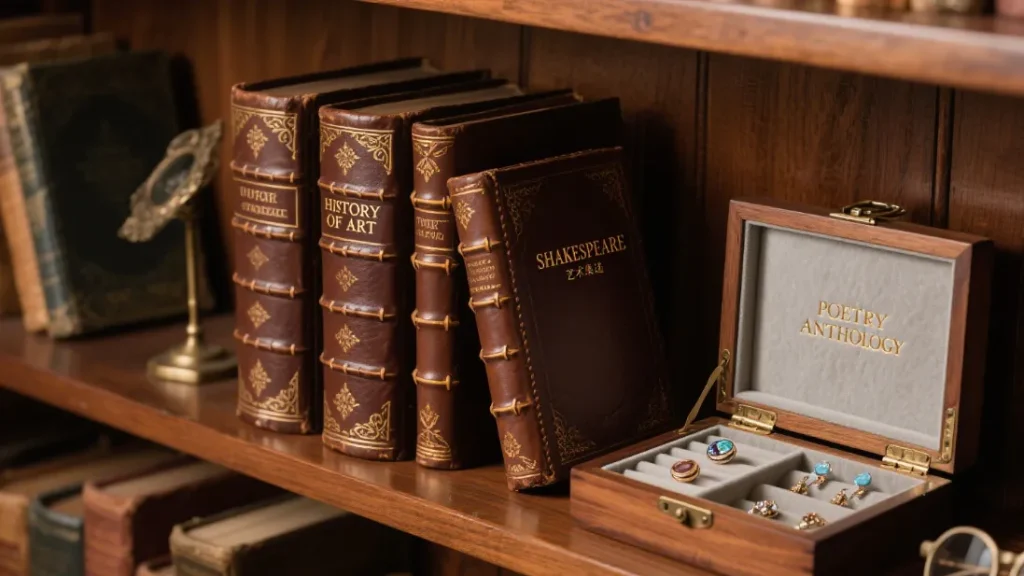
Book-shaped jewelry boxes disguise their true purpose through clever mimicry. From the outside, these designs resemble vintage hardcover books, complete with spine details and sometimes decorative “page” edges created with gilding or marbling techniques. This disguise serves both aesthetic and security purposes—valuable jewelry remains concealed in plain sight among actual books on a shelf. When opened, the “pages” reveal specially designed compartments for various jewelry types. Literary enthusiasts particularly appreciate these designs, which often feature titles or decorative elements referencing classic literature or meaningful texts.
Animal-inspired boxes
Animal-inspired boxes transform functional storage into whimsical creatures or beloved pets. These might take literal approaches, with boxes shaped like elephants, owls, turtles, or other animals, or more subtle designs that incorporate animal motifs into traditional box forms. Some feature realistic carving techniques that capture remarkable detail, while others take more stylized or abstract approaches. The animal connection often makes these boxes particularly appealing as gifts for children or for adults with special connections to specific creatures. Beyond their decorative appeal, animal forms sometimes influence functional elements—a turtle’s shell might lift to reveal storage, or an owl’s wings might open to expose compartments.
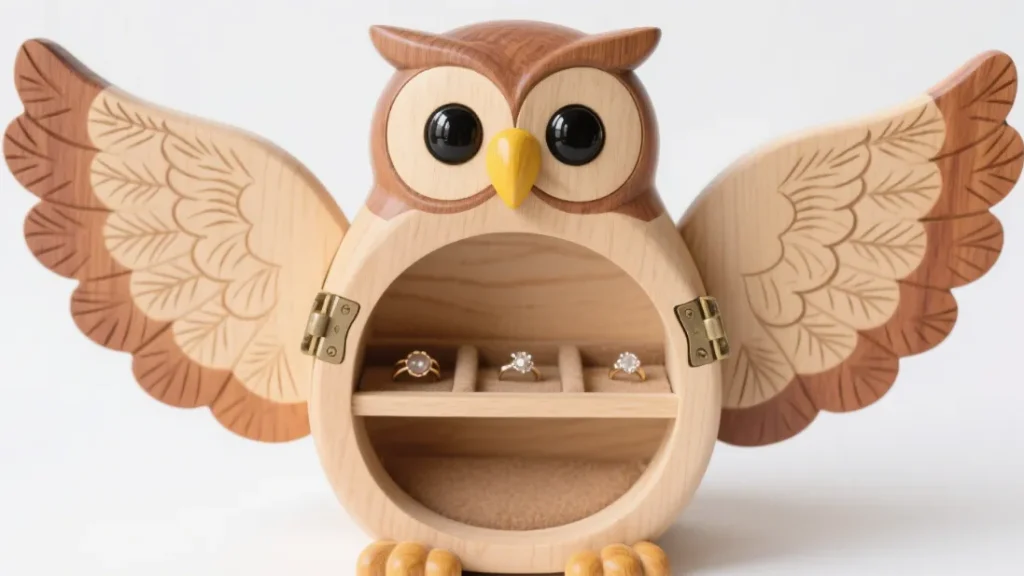
Puzzle boxes
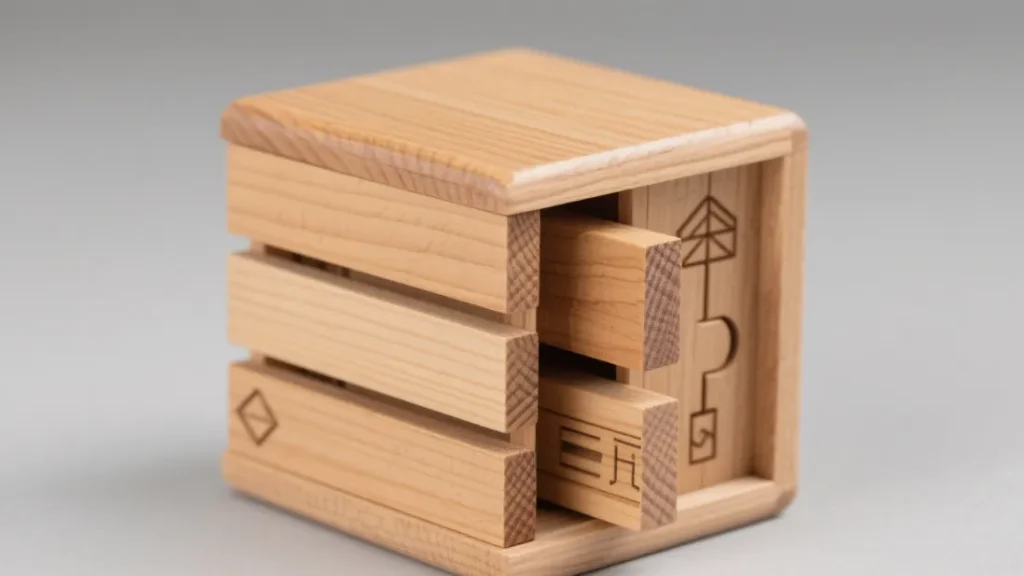
Puzzle boxes combine jewelry storage with the intellectual engagement of mechanical puzzles. These clever designs require specific movements, sequences, or solutions to open, adding an element of play and security to jewelry storage. Some draw inspiration from historical traditions like Japanese Yosegi puzzle boxes, which might require multiple precise sliding movements in a particular order to reveal their contents. Others incorporate modern puzzle concepts like hidden magnets, pressure points, or optical illusions. Beyond their entertainment value, puzzle boxes offer practical security advantages—a would-be thief unfamiliar with the opening mechanism would struggle to access the contents.
Laser-cut pattern designs
Laser-cut pattern designs utilize modern technology to achieve decorative effects impossible through traditional methods. Precision laser cutting allows for incredibly detailed patterns to be cut through thin wood veneers or directly into solid box components. These might include intricate geometric designs, filigree effects, or even photographic imagery translated into cut patterns. When lined with contrasting materials, these perforations create beautiful light and shadow effects. Some designs incorporate LED lighting behind laser-cut panels, creating dramatic illuminated patterns when the box is opened or activated.
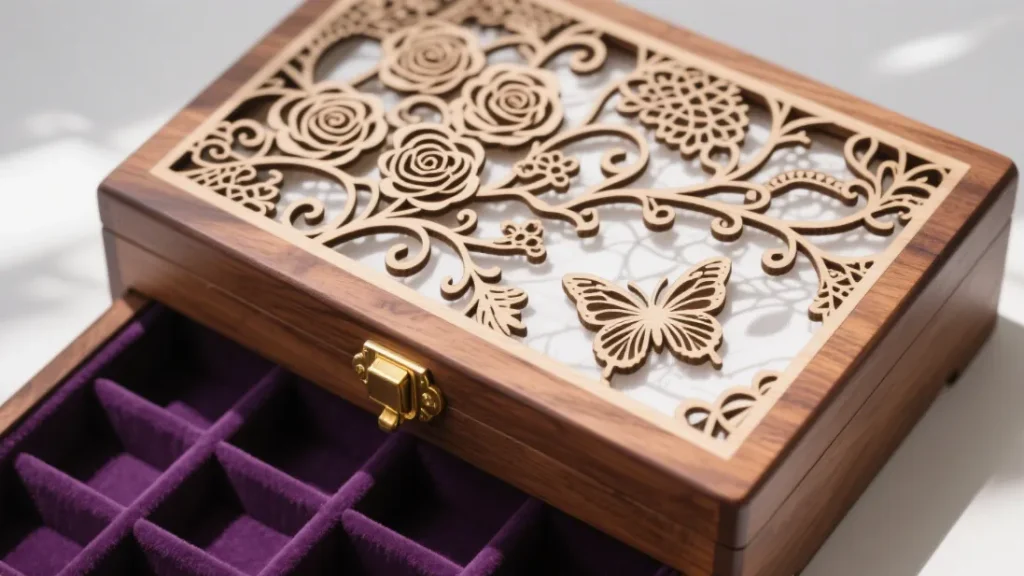
CNC carved 3D landscape boxes
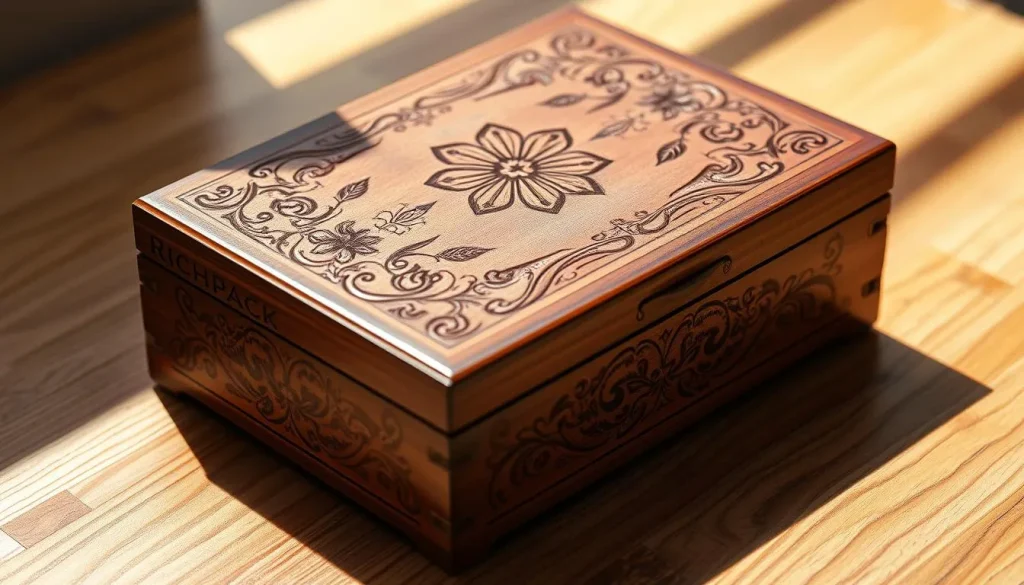
CNC carved 3D landscape boxes feature topographically accurate terrain reproduced in wood through computer-controlled carving. Mountain ranges, river valleys, or coastlines meaningful to the owner might be precisely recreated on the lid or sides. These carvings can represent actual geographic locations—perhaps where a couple met or a favorite vacation destination—adding personal significance to the jewelry storage. The three-dimensional quality invites touch, creating a tactile connection to landscapes with emotional resonance. Some designs enhance the carved landscapes with subtle color applications or inlaid elements representing water features or vegetation.
Resin and wood combination boxes
Resin and wood combination boxes leverage the complementary qualities of these contrasting materials. Artisans might fill natural cracks or intentionally created voids in wood with colored resin, creating river-like effects or geometric patterns that showcase both materials’ beauty. The transparency of resin allows for creative inclusions—small botanical specimens, metal flakes, or even tiny decorative elements suspended within. The resulting pieces often feature striking color contrasts impossible with wood alone. Particularly stunning examples utilize bioluminescent pigments in the resin that glow softly in darkness, creating magical effects without electronics.
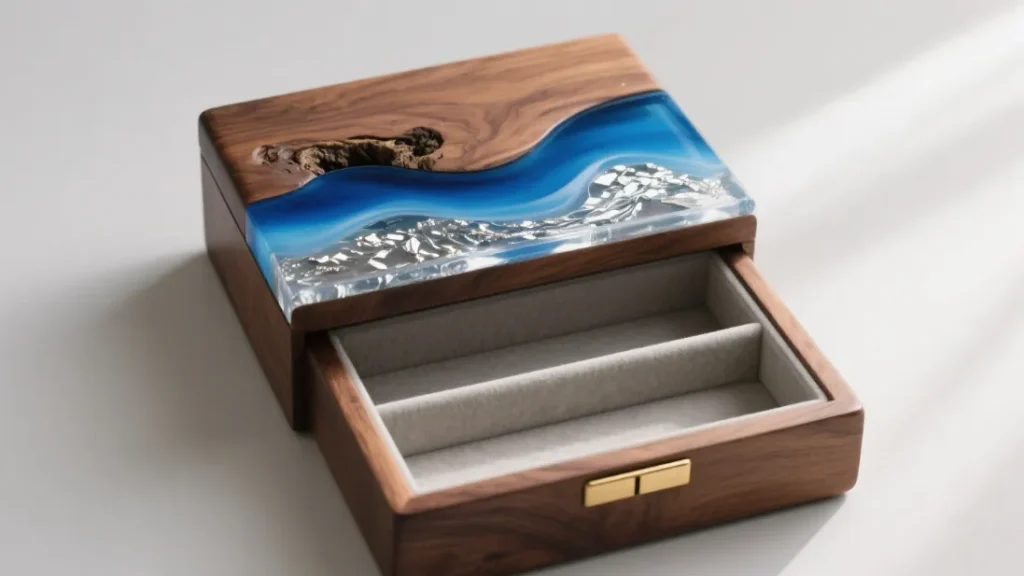
Backlit wood design boxes
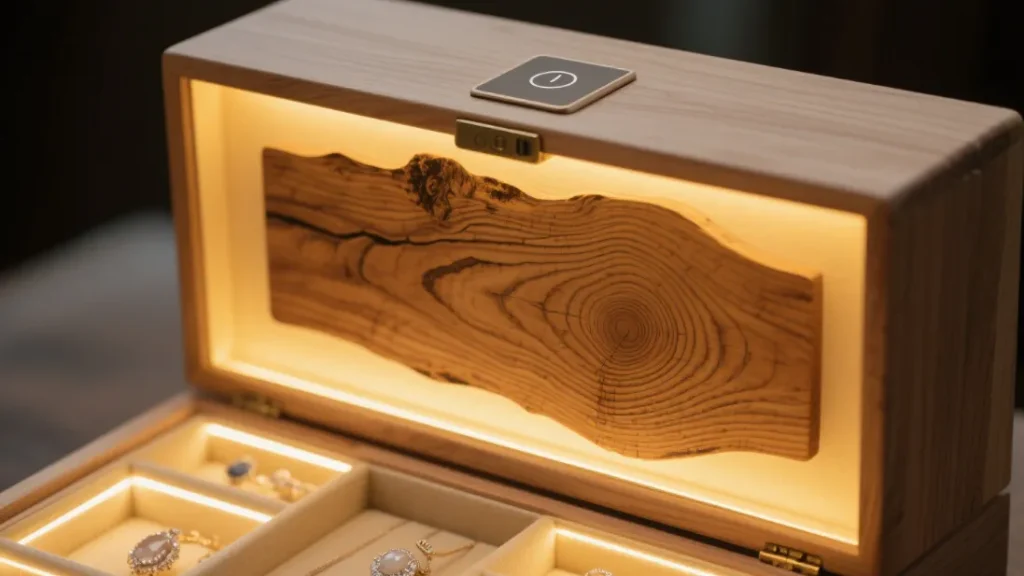
Backlit wood design boxes incorporate thin sections of wood specifically selected or prepared to allow light transmission. When illuminated from behind, these translucent areas reveal the wood’s internal structure in extraordinary detail—growth rings, grain patterns, and variations in density become visible in ways normally hidden. Some designs use specially prepared wood veneers sliced so thinly that light passes through them like amber. Others incorporate panels where wood has been selectively reduced in thickness to create imagery that only becomes visible when backlit. LED technology makes these effects practical for jewelry boxes, with thin battery-powered lighting elements easily concealed within the structure.
Kinetic art boxes
Kinetic art boxes transform static storage into dynamic visual experiences. These sophisticated designs incorporate moving elements that change as the box is opened or manipulated. Some feature wooden gears, levers, or linkages that create choreographed movements when activated. Others might include balanced elements that respond to gravity or magnetic components that interact in surprising ways. The movement might serve purely aesthetic purposes or could be integrated into the functional aspects of jewelry access and display. These kinetic elements connect wooden jewelry boxes to the rich tradition of automata and mechanical art while creating moments of delight with each use.
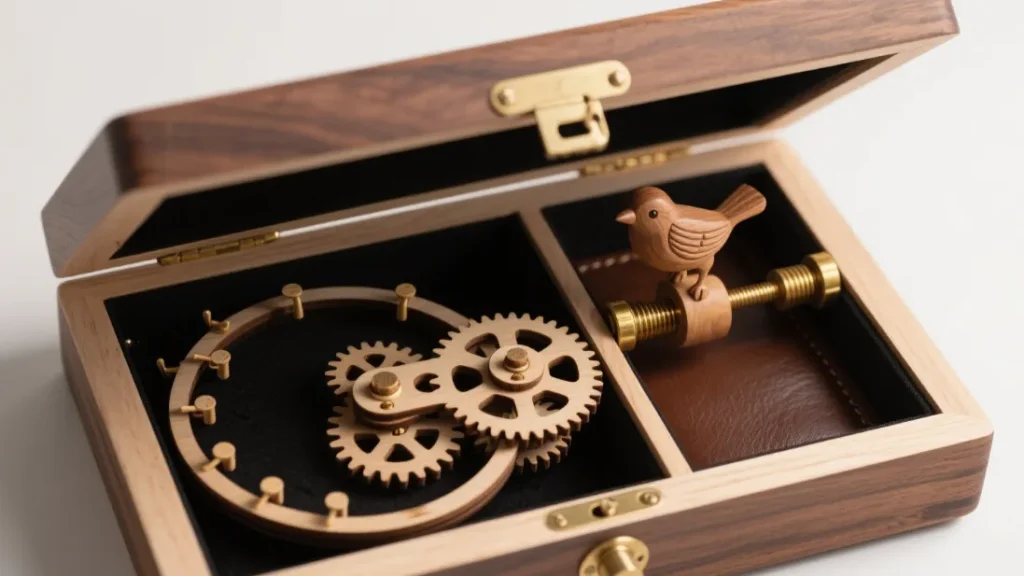
Creative and artistic wooden jewelry boxes demonstrate the limitless possibilities when functional objects become vehicles for personal expression. They remind us that necessary storage can transcend mere utility to become a daily source of beauty, meaning, and joy. Whether showcasing traditional handcraft techniques or leveraging modern technology, these innovative designs prove that even the most practical items in our homes can reflect our aesthetic values and creative spirit.
Creating your own wooden jewelry box offers a rewarding introduction to woodworking while producing a practical item that can be treasured for years. For beginners, wooden jewelry boxes represent an ideal first project—they require minimal materials, teach fundamental techniques, and result in a functional item that makes a wonderful gift or personal keepsake.
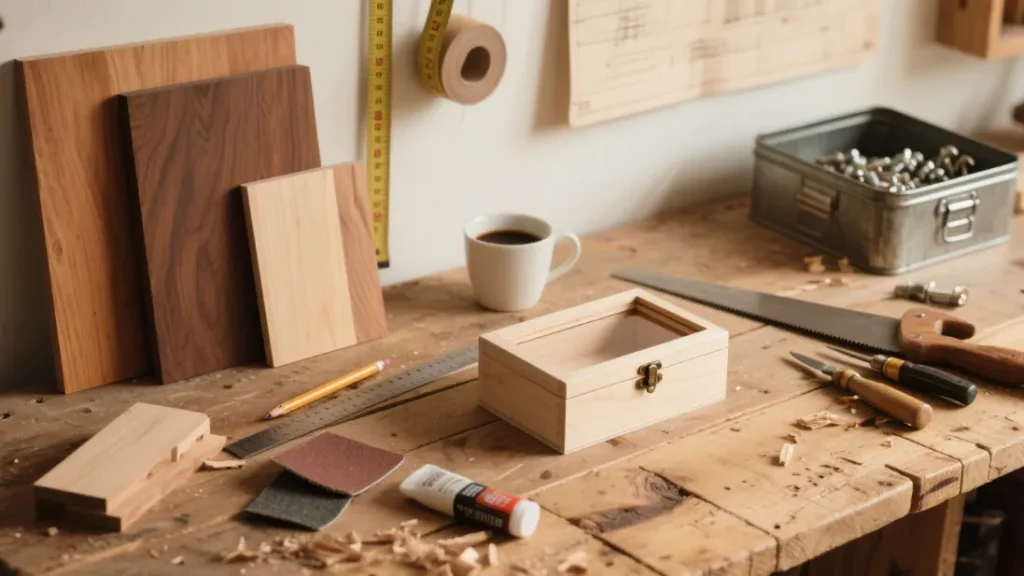
The beauty of DIY jewelry box projects lies in their scalability. You can start with extremely simple designs requiring basic tools and straightforward techniques, then gradually incorporate more complex features as your skills and confidence grow. Each box becomes both a showcase for your developing craftsmanship and a practical storage solution for precious items.
One of the most appealing aspects of making wooden jewelry boxes is the opportunity to work with beautiful hardwoods without significant expense. Since boxes require relatively small amounts of material, you can experiment with exotic or figured woods that might be prohibitively expensive for larger projects. This allows beginners to experience the joy of working with premium materials without breaking the budget.
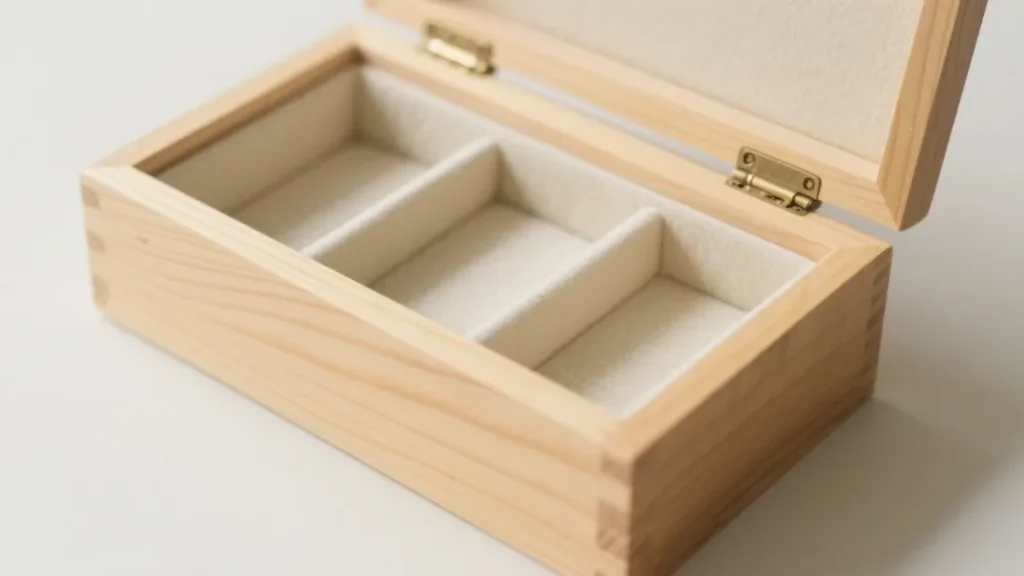
The basic mitered corner box represents perhaps the most straightforward entry point into jewelry box making. This design uses 45-degree mitered corners for a clean look without complicated joinery. The construction typically involves cutting side pieces to the same width and appropriate lengths, then joining them with simple mitered corners. What makes this design particularly beginner-friendly is that it requires minimal specialized tools—primarily a saw capable of making precise 45-degree cuts and clamps for assembly.
Upcycled drawer conversion offers a clever way to create a jewelry box with minimal woodworking. By repurposing an old drawer—perhaps from a discarded dresser or desk—you can skip much of the box construction process. The existing drawer structure provides the sides and bottom, requiring only minimal modification to transform it into a dedicated jewelry box. You might add dividers, a custom liner, or a new finish to complete the transformation. This approach not only simplifies the process but also gives new life to materials that might otherwise be discarded.
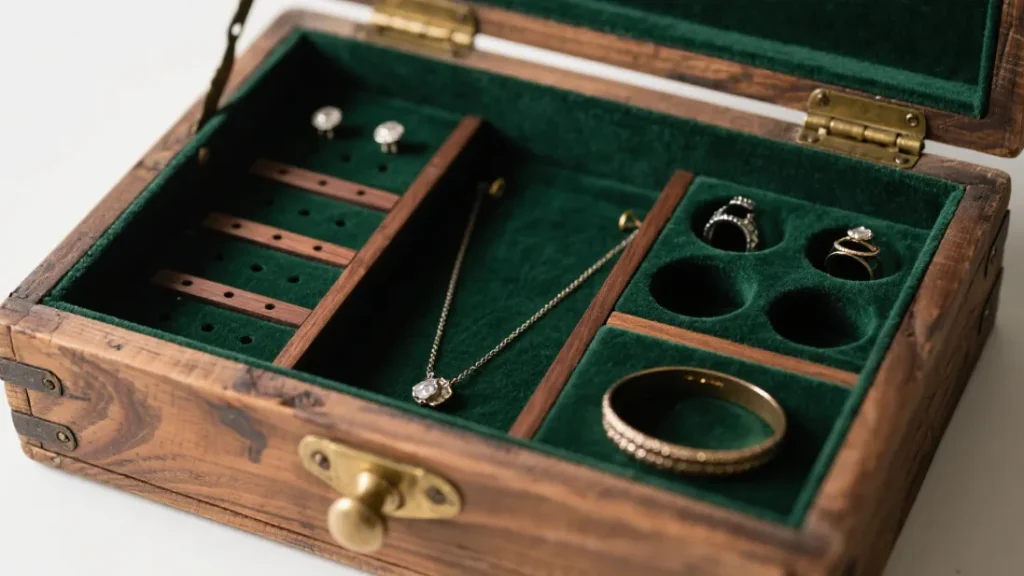
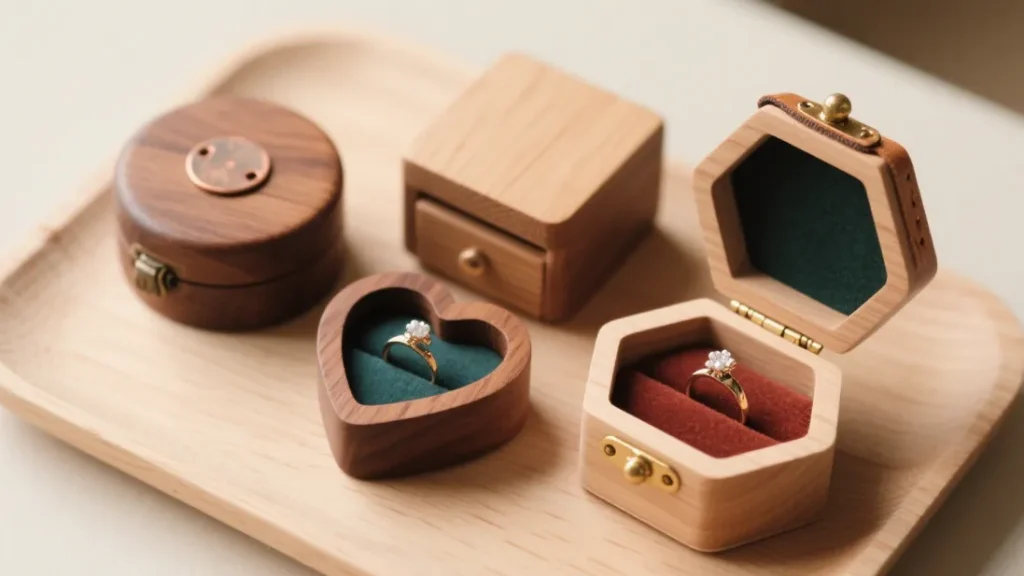
Small trinket boxes provide perfect practice for basic box-making techniques while requiring minimal materials. These tiny containers—often just a few inches square—can be used for rings, earrings, or other small treasures. Their compact size makes them less intimidating for beginners and allows you to complete a project quickly, providing immediate satisfaction. Despite their simplicity, these small boxes teach essential skills like precise measuring, clean cutting, and careful assembly that apply to more complex projects.
The bandsaw box represents a unique approach to box making that produces organic, sculptural forms. Created by cutting shapes from a solid block of wood using primarily a bandsaw, these boxes have a distinctive handcrafted quality. The process involves cutting away the center of a wooden block to create the cavity, then cutting a thin slice from the front or back to create a lid. This technique produces boxes with seamless, flowing lines impossible to achieve with traditional joinery. While a bandsaw is required, the process itself is surprisingly straightforward and forgiving for beginners.

Picture frame box construction adapts familiar picture frame-making techniques to create shallow boxes with glass or clear tops. These display-style jewelry boxes work particularly well for collections of flat items like pins, brooches, or special medallions that benefit from being visible even when stored. The construction mimics that of a deep picture frame, with mitered corners and a rabbet to hold the glass. This project teaches rabbet-cutting techniques while creating a specialized storage solution for certain types of jewelry collections.
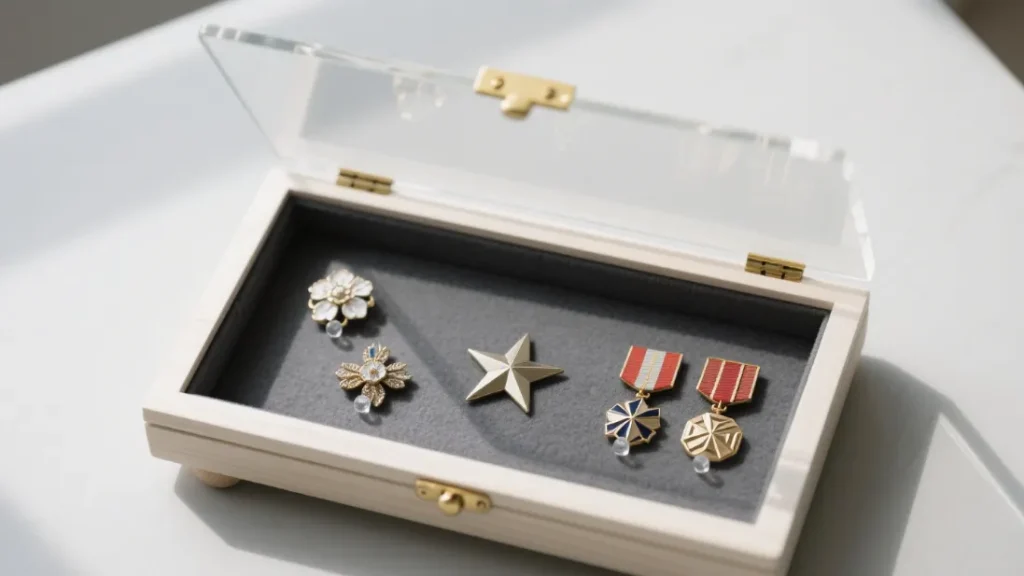
Once you’re familiar with these basic concepts, you might be eager to start your first project. If you’re ready, we have the perfect starting point: a detailed, step-by-step tutorial on how to make a small wooden jewelry box that will guide you through the entire process.
Basic box joinery represents the foundation of successful box making. While mitered corners offer a clean, simple approach, understanding various joinery options expands your capabilities significantly. Box joints (sometimes called finger joints) provide excellent strength and an attractive appearance with their interlocking “fingers.” Dovetail joints, while more challenging, create exceptionally strong connections with distinctive visual appeal. Learning these joinery techniques not only improves your boxes but builds skills applicable to many woodworking projects.
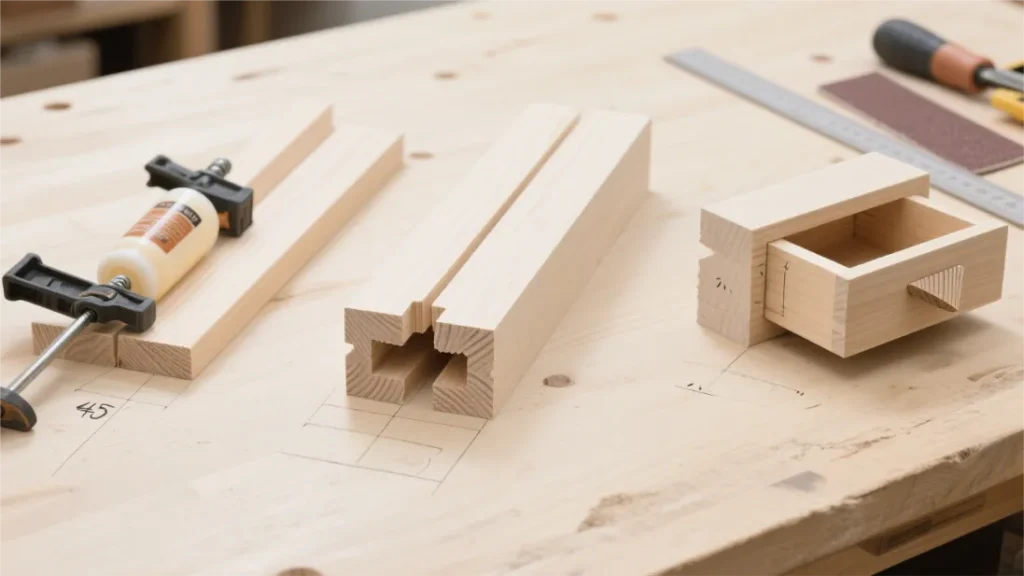
Lid fitting techniques make the difference between a frustrating box that sticks or gaps and one that opens and closes with satisfying precision. When creating a basic box with a fitted lid, you must ensure the lid is properly sized—if you make it too long, you won’t be able to put the box together. Different lid styles—including drop-in lids, hinged tops, and sliding lids—each require specific approaches to achieve proper fit. Mastering these techniques ensures your boxes function as beautifully as they look.
Simple lining installation transforms a wooden box into a proper jewelry box by providing soft protection for valuable items. Felt is a common choice for box linings, with scissors often working better than knives for cutting it to size. The process involves carefully measuring and cutting the material, then applying a thin layer of glue to the wood surface before smoothing the lining into place. Learning to work with fabric materials adds a new dimension to your woodworking skills and significantly enhances the functionality of your jewelry boxes.
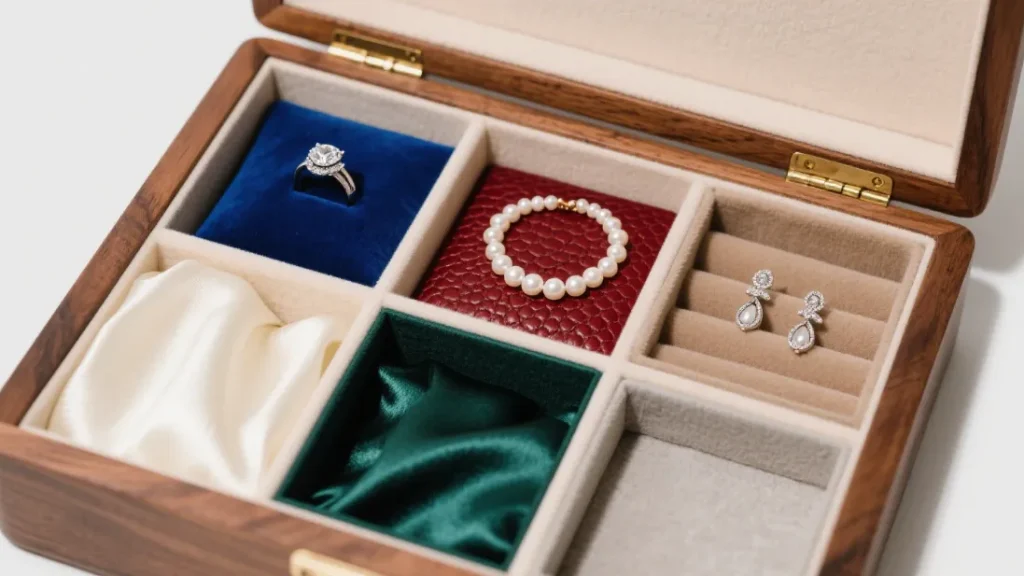
Finishing techniques bring out the natural beauty of wood while providing protection for your completed project. For beginners, simple oil finishes like mineral oil or Danish oil offer foolproof application with beautiful results. As your skills advance, you might explore shellac, polyurethane, or lacquer finishes that provide greater durability and various sheen levels. For a smooth finish, always start with a well-sanded project, sand between coats with fine-grit paper, wipe clean, and apply light coats with a foam brush or roller. Mastering finishing techniques ensures your projects look professional and will stand the test of time.
Basic hardware installation adds functionality and refinement to your jewelry boxes. Learning to properly install hinges ensures lids operate smoothly, while catches and locks provide security. Knobs and pulls enhance both appearance and usability. The key to successful hardware installation lies in precise measurement and drilling, ensuring components align perfectly. Starting with simple hardware builds confidence before attempting more complex mechanisms like secret compartments or specialized jewelry organizers.
DIY wooden jewelry box projects provide the perfect introduction to woodworking—offering achievable challenges, minimal material requirements, and practical results. As you progress from simple designs to more complex creations, each project builds skills that transfer to other woodworking endeavors. The satisfaction of creating a beautiful, functional object with your own hands makes jewelry box construction particularly rewarding for beginners. Whether crafted for personal use or as thoughtful gifts, these handmade wooden treasures combine utility with personal expression in a way mass-produced alternatives simply cannot match.
While the exterior of a wooden jewelry box showcases craftsmanship and beauty, the interior lining plays an equally crucial role in protecting your valuable pieces. A well-chosen lining not only prevents scratches and damage but also enhances the overall presentation of your jewelry collection and completes the aesthetic of your box.
The perfect interior creates a protective microenvironment for metals and gemstones while providing the right backdrop to showcase your treasures. Different materials offer varying levels of protection, appearance, and durability—making the selection of lining materials an important consideration whether you’re purchasing a finished box or creating your own.
Beyond protection, lining materials contribute significantly to the user experience. The tactile sensation when retrieving jewelry, the visual contrast that helps pieces stand out, and even the slight sound dampening that suggests quality and luxury all stem from thoughtful lining choices. The best jewelry boxes consider these sensory aspects alongside practical protection.
Velvet
The tactile experience is paramount, and the choice of lining can define the box’s perceived value. For a deeper comparison, explore our analysis of jewelry packaging with velvety vs. soft fabric linings and which offers a more premium feel.
Velvet remains the classic choice for jewelry box linings, having been used for this purpose for centuries. Its dense, short pile creates a soft, protective surface that prevents metals from scratching while providing a luxurious backdrop for gemstones. Traditional velvet made from silk offers the ultimate in luxury, though modern synthetic velvets provide similar protection at more accessible price points. Color choice matters significantly—rich jewel tones like royal blue, emerald green, and burgundy create dramatic backgrounds that make metals pop, while neutral tones like black, gray, or cream offer versatile backdrops for any jewelry style.
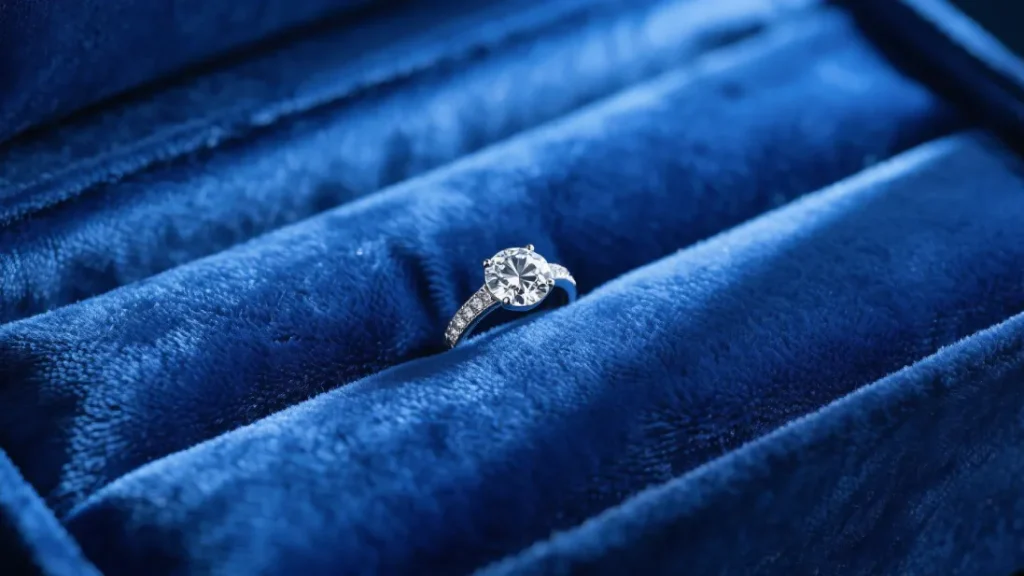
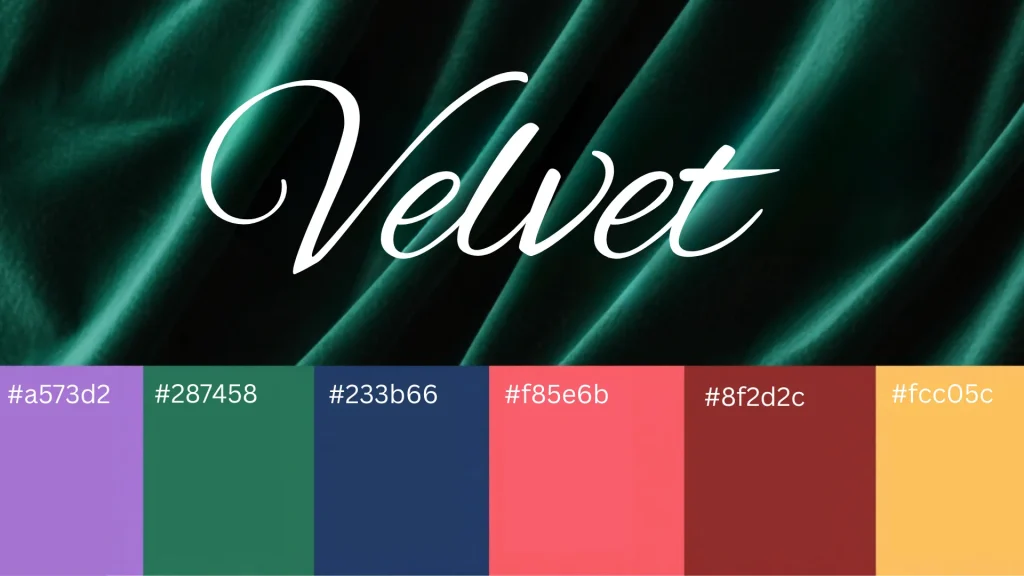
Velvet is undoubtedly a classic and luxurious choice. If you have an unlined wooden box or want to add a professional touch to your DIY project, learning to install a lining is key. You can master this skill by following our step-by-step guide on how to line a jewelry box with velvet.
Suede
Suede interior linings offer a sophisticated alternative with a distinctively different texture than velvet. The napped surface provides excellent protection while offering a more contemporary feel than traditional velvet. Natural suede, typically made from split leather, brings organic warmth and character but requires careful handling during installation to prevent stretching.
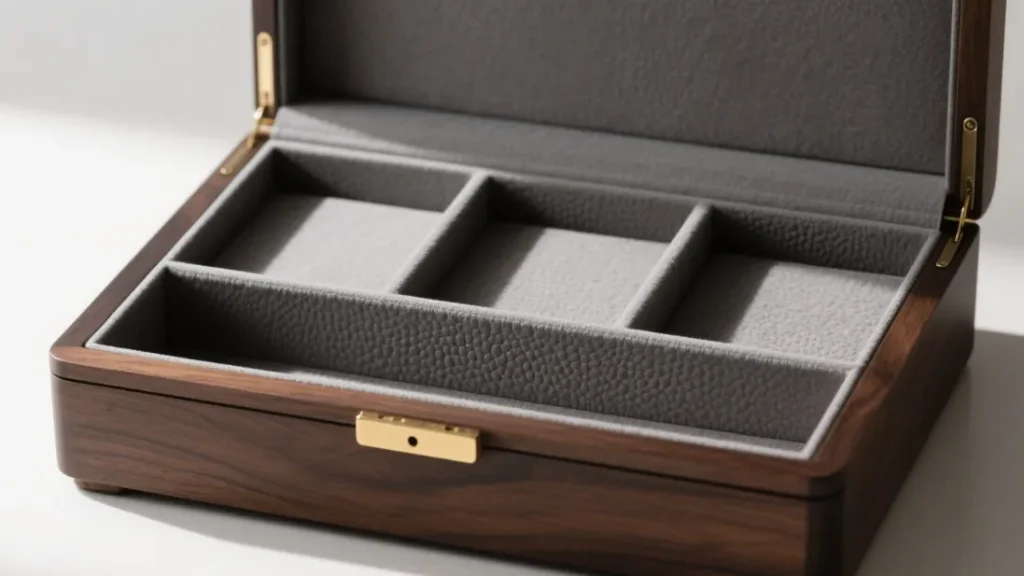
Microsuede and ultrasuede, synthetic alternatives, offer similar appearance and protection with improved stain resistance and consistency. The slightly rougher texture of suede helps prevent jewelry from sliding around in compartments, an advantage for boxes that might be moved frequently.
Silk
Silk lining creates an elegant, smooth surface with subtle luster that complements fine jewelry beautifully. This premium natural fiber has been associated with luxury for thousands of years, and its use in jewelry boxes continues this tradition.
Silk provides excellent protection for delicate pieces while adding a distinctive sheen that enhances the presentation of your collection. While more challenging to install than other options due to its tendency to fray and its delicate nature, the results justify the extra effort for special projects. For maximum luxury, charmeuse silk with its characteristic smooth face and slightly textured back offers ideal properties for jewelry box lining.
Felt
Felt application represents perhaps the most accessible option for DIY jewelry box projects. Available in craft stores in a rainbow of colors, felt is affordable, easy to cut, and straightforward to install with basic craft adhesives. While not as luxurious as velvet or silk, quality wool felt provides excellent protection and a clean, contemporary appearance. Its slight thickness helps dampen movement and noise when the box is transported. For beginning woodworkers creating their first jewelry boxes, felt offers a forgiving material that allows for successful lining without specialized skills or tools.
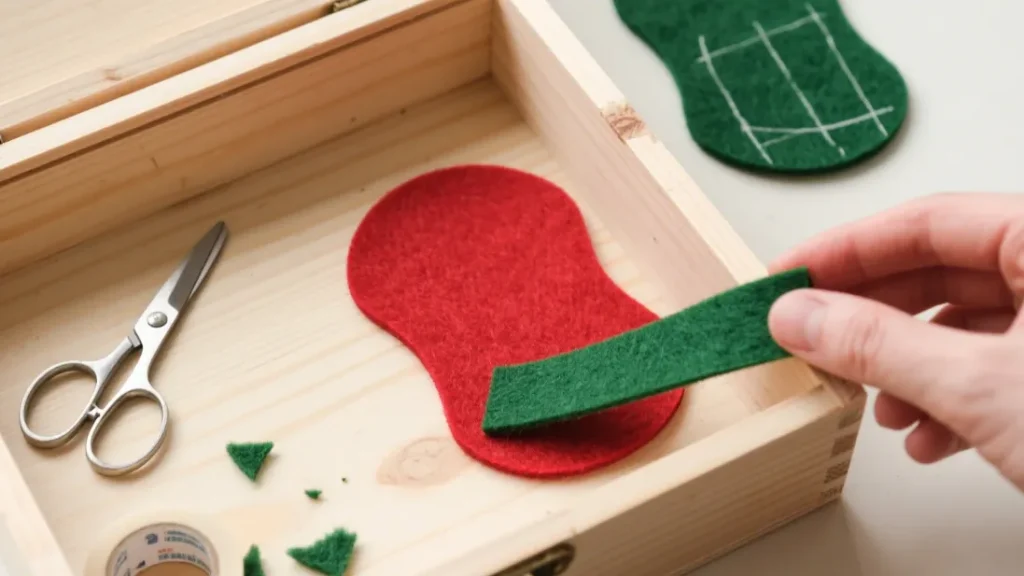
Padded quilted lining
Padded quilted lining takes jewelry protection to another level by incorporating a thin layer of batting or foam beneath the visible fabric. This technique creates a cushioned surface that cradles jewelry pieces while adding visual dimension through the quilted texture. Typically, small diamond or rectangular patterns are created either through stitching or adhesive techniques.
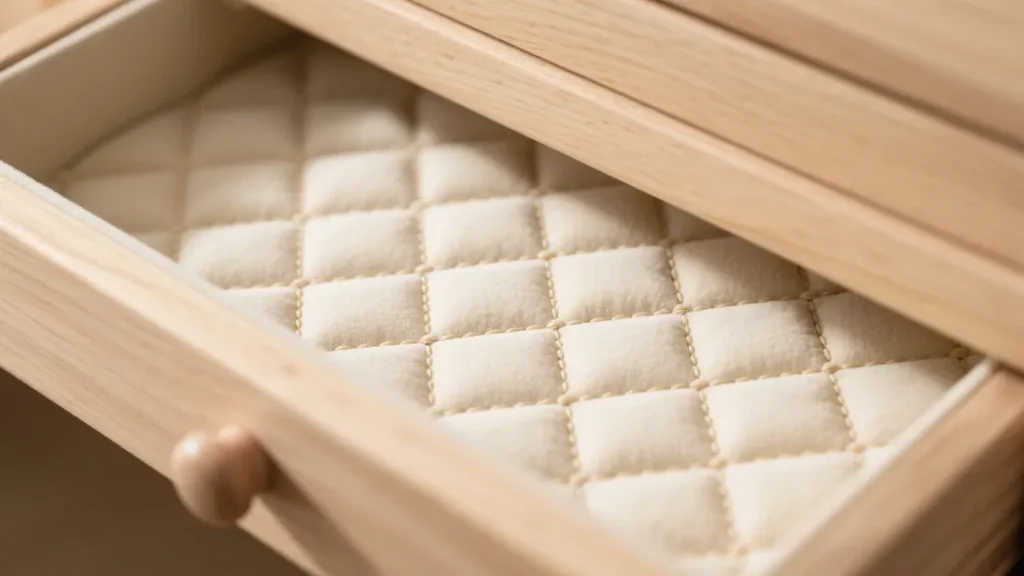
The padding is particularly beneficial for watches and bracelets, preventing movement and potential damage. This approach works well for drawer bottoms and specialized compartments where additional protection is desired.
Ring roll inserts transform flat compartments into specialized ring storage. These cylindrical cushions, typically covered in velvet or similar material, feature slight indentations along their length that secure rings in place. The raised design allows for maximum visibility of your collection while preventing rings from touching each other. For engagement rings and other pieces with prominent stones, ring rolls help prevent prongs from catching on fabric or other jewelry. Custom-sized rolls can be created for DIY projects using foam pipe insulation as a base, then covered with your chosen fabric for a professional appearance.
Necklace hooks and holders prevent one of the most common jewelry frustrations—tangled chains. Specialized panels with small hooks, slots, or clips keep necklaces hanging straight and separated from each other. The most effective designs position these hooks against padded backing to prevent scratching from the hardware itself. For longer necklaces, retractable or fold-out panels maximize storage capacity while maintaining full length hanging. Some innovative designs incorporate hidden magnets beneath fabric surfaces, allowing chains to be secured without visible hardware for a cleaner appearance.
Earring organization systems solve the perpetual challenge of keeping pairs together while accommodating various earring styles. For stud earrings, panels with small holes allow posts to be inserted securely. Hanging earrings benefit from slotted panels that keep hooks organized while allowing dangles to hang freely. The most versatile systems combine both approaches, accommodating mixed collections. Some creative solutions use strips of tightly woven ribbon or specialized fabric that allow earring hooks to be inserted anywhere along the surface, providing flexible organization that adapts to your collection.
Earring organization systems
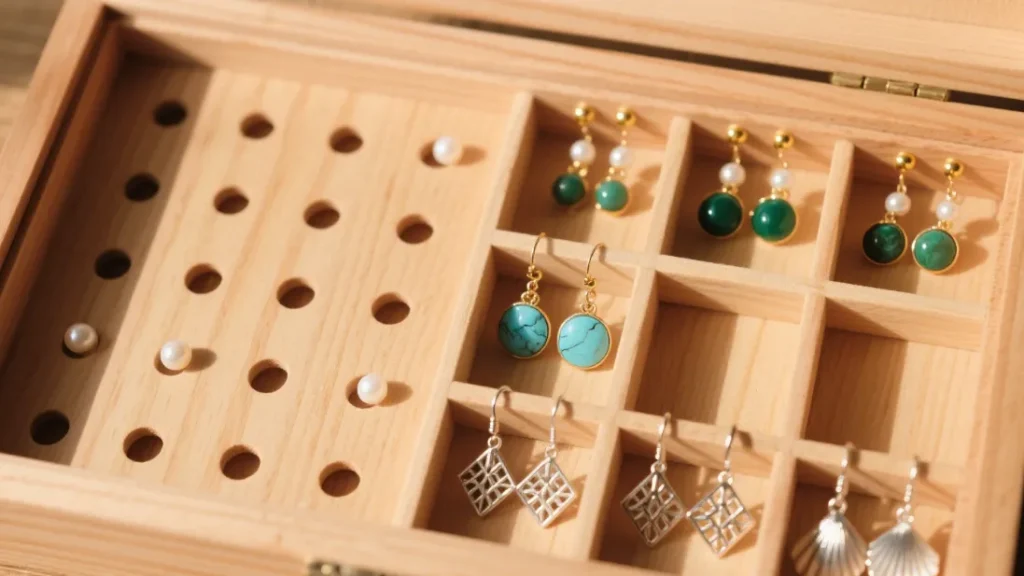
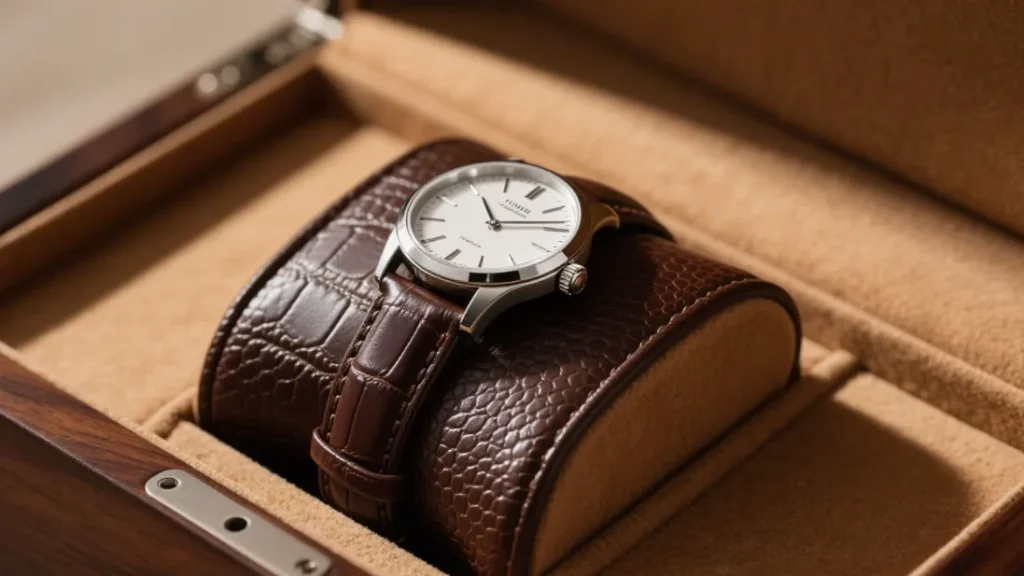
Watch cushions
Watch cushions provide specialized support for timepieces, whether luxury mechanical watches or everyday wearables. These padded forms, typically cylindrical or slightly oval, allow watches to be stored with bands naturally curved rather than folded or crimped. Quality watch cushions are firm enough to maintain shape but yielding enough to prevent strain on watch bands or clasps. For serious watch collectors, cushions with varying diameters accommodate different watch sizes, from delicate dress watches to substantial sports models. The best versions use materials that prevent scratching on case backs while providing sufficient grip to keep watches positioned properly.
Removable trays create versatile multi-level storage that maximizes organization in a single box. These lift-out inserts typically feature their own specialized compartments tailored to specific jewelry types. When placed in the box, they cover deeper storage areas below, effectively doubling or tripling the usable space. Quality removable trays feature precisely fitted dimensions that prevent shifting when the box is moved while allowing easy removal when needed. For DIY projects, creating simple removable trays with finger holes or small handles offers an excellent way to enhance storage capacity without requiring complex joinery or hardware.
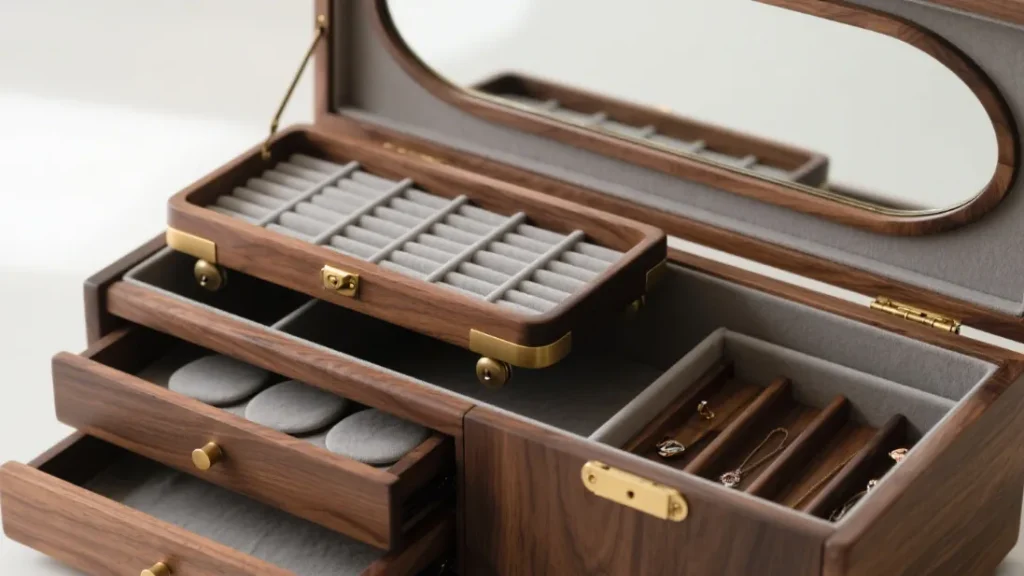
The interior lining of a jewelry box represents the final touch that transforms a wooden container into a proper jewelry box. By selecting appropriate materials and specialized features tailored to your specific collection, you ensure both the protection of your valuable pieces and the pleasure of using your jewelry box daily. Whether you prefer traditional luxury materials or innovative modern solutions, the right interior creates the perfect environment for the treasures you cherish.
With so many beautiful wooden jewelry box designs to choose from, finding or creating the perfect one comes down to understanding your personal needs, aesthetic preferences, and how you’ll use it in daily life. The journey to the ideal jewelry box begins with a thoughtful assessment of your specific requirements.
As you consider the perfect design, it’s also wise to look toward the future. To stay ahead of the curve, we’ve compiled a forecast of the top 25 jewelry box designs for 2025 that every jeweler should know.
To find the perfect box, consider the following key aspects:
Your Collection
Different jewelry types demand different storage solutions. Choose a design with versatile or specialized compartments that fit what you own.
Placement Location
Consider where the box will sit. A compact design might be best for a bedside table, while a larger chest could work on a dresser.
Personal Aesthetic:
The wood species and design style should reflect your personal taste and complement your home decor.
Practical Needs:
Think about security features like locks or hidden compartments if you have valuable pieces. For DIYers, honestly assess your skill level and tools before choosing a plan.
Remember that the best wooden jewelry box is ultimately one that brings you joy each time you use it. It should make accessing your jewelry a pleasure rather than a chore, protect your valuable pieces effectively, and enhance your space with its beauty. Whether antique or modern, simple or elaborate, handmade or professionally crafted, the perfect wooden jewelry box creates a worthy home for the treasures you wear closest to your heart.
While a personal handmade box is a treasure, jewelry brands and retailers require solutions that are scalable, consistent, and reflective of their brand identity. The impact of professional packaging is significant; a study by the Paper and Packaging Board found that 72% of consumers agree that packaging design can influence their purchasing decision. This is where a partnership with an experienced supplier becomes invaluable.
At Richpack, we specialize in turning design concepts like the ones you’ve seen into reality for global brands. With a monthly capacity of 3 million pieces and a commitment to sustainable, high-quality materials, we offer a one-stop-shop for custom jewelry packaging wholesale solutions. If you are a jewelry brand, wholesaler, or retailer looking to elevate your presentation with bespoke packaging that meets strict deadlines and quality standards, we invite you to contact us to discuss your unique needs.
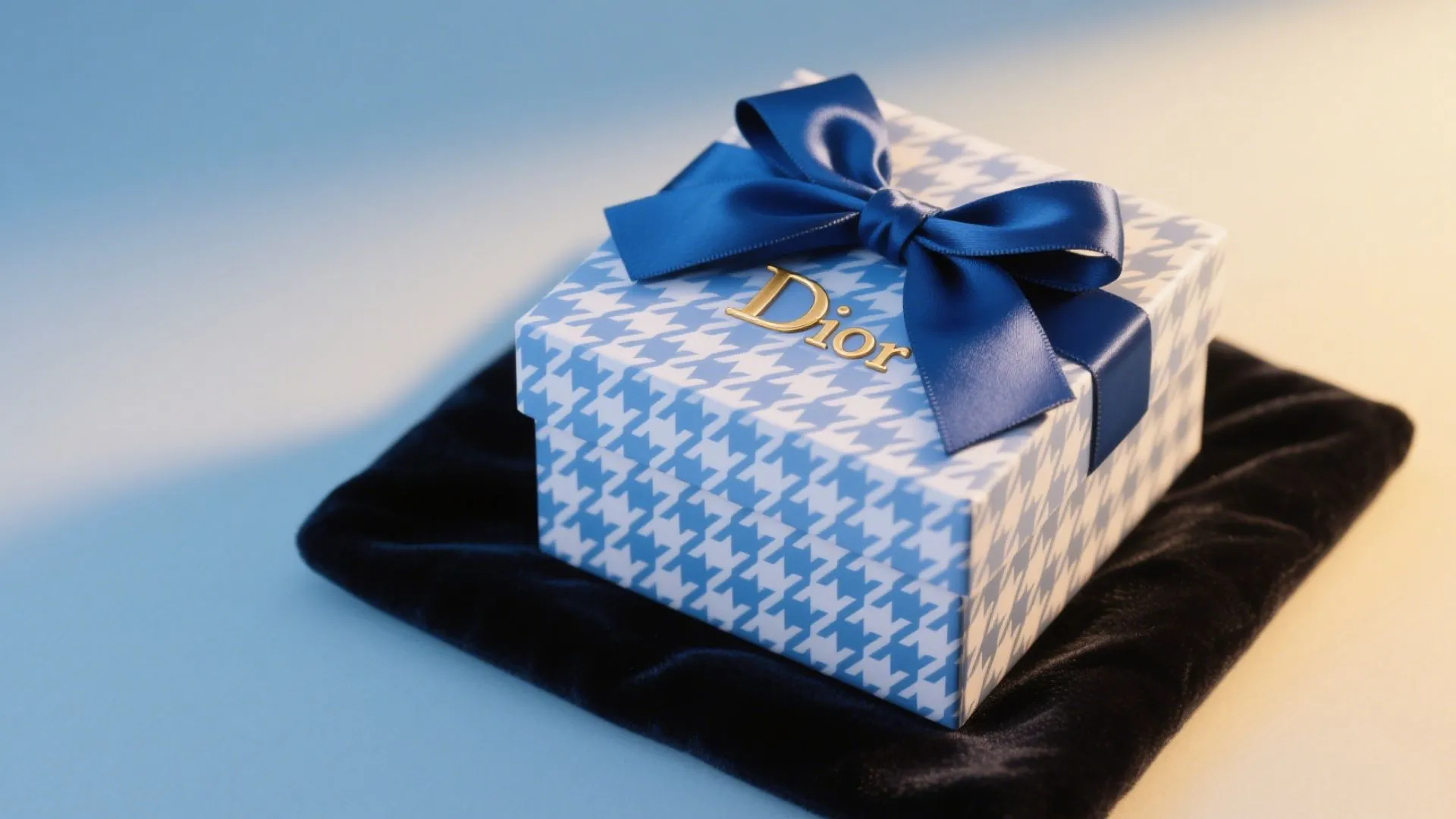
Gift-giving is an age-old tradition that brings joy to both the giver and the receiver. However, the presentation of a gift is just as important as the gift itself. One way to enhance the beauty and appeal of your presents is by using decorative gift boxes with lids. These elegant containers not only add a… Continue reading Top 50+ Stunning Wooden Jewelry Box Designs Ideas
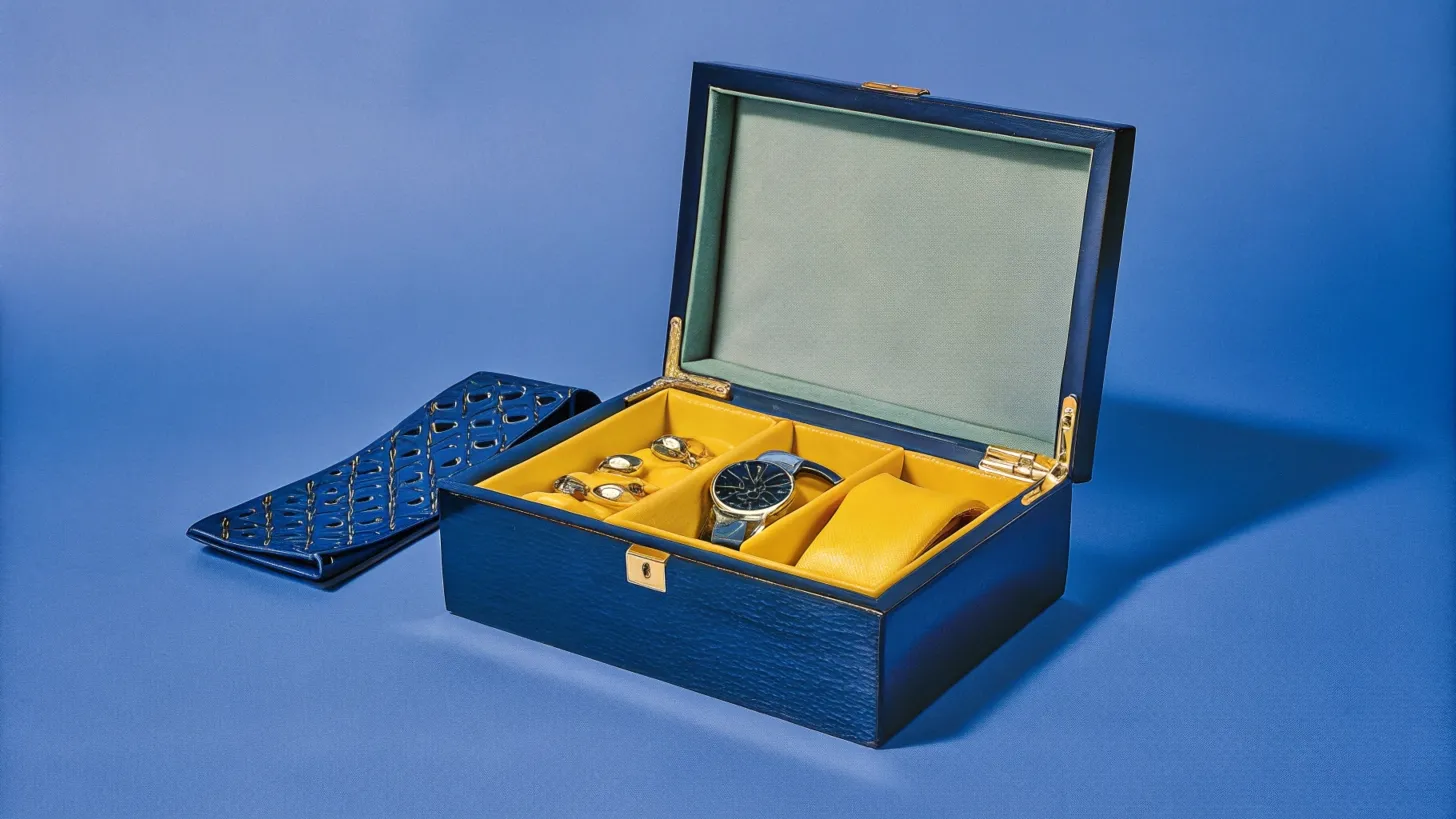
Stereotypically, men are associated with jewelry boxes and even jewelry, however. the survey found that men are more likely to be frequent shoppers online and on Amazon. This inspired us to firmly grasp the online men’s jewelry box market. This article introduces men’s jewellery boxes, exploring the history and background, different styles, materials, and features that make… Continue reading Top 50+ Stunning Wooden Jewelry Box Designs Ideas
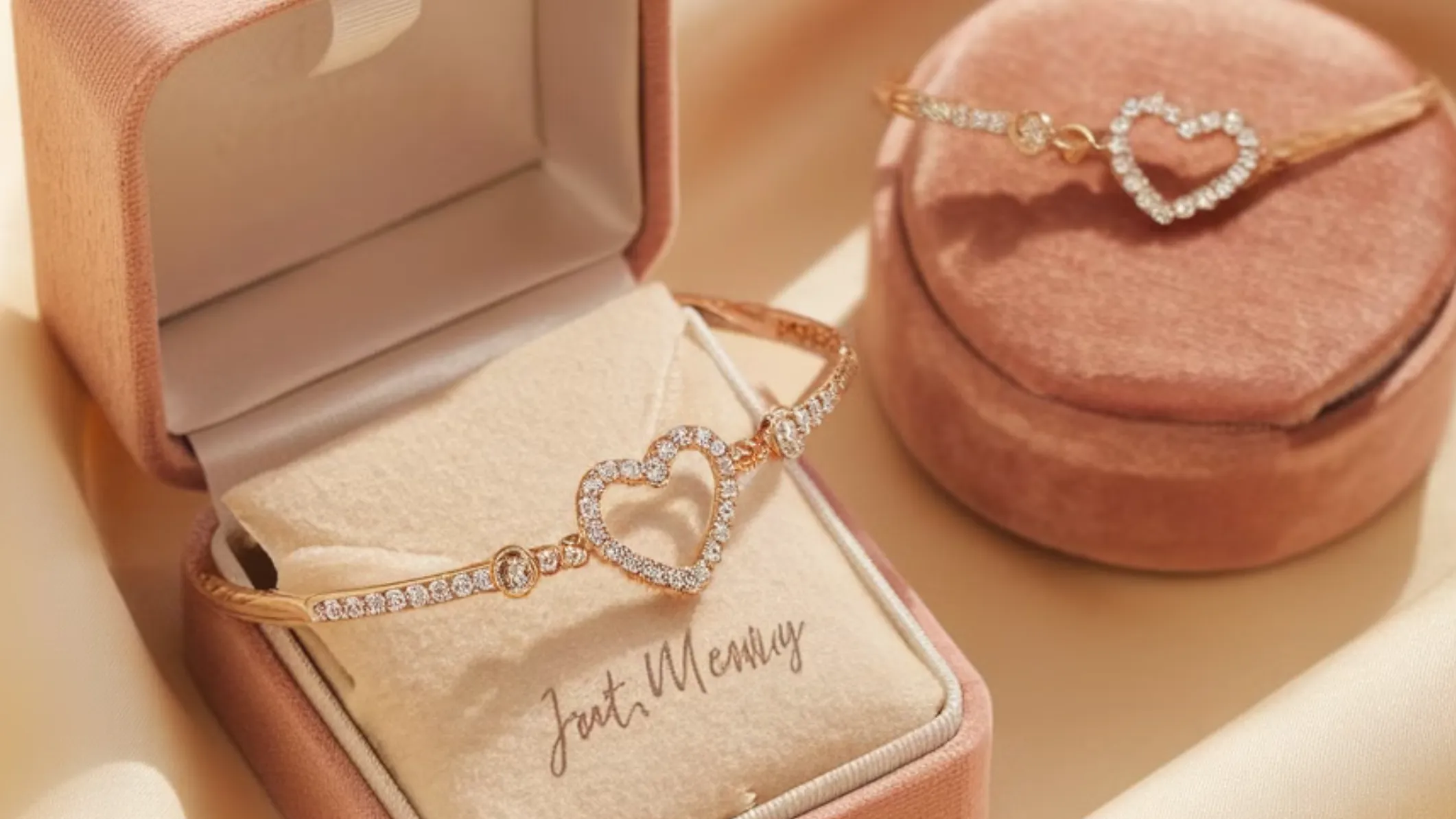
Richpack Custom Jewelry Packaing · Paper Vs. Velvet Jewelry Boxes Which Is Better For Your Brand Your packaging must be your brand’s dedicated 24/7 ambassador. For example, the choice of materials, design, and craftsmanship will become key factors in shaping consumers’ perceptions and influencing their purchasing decisions. Choosing between paper and velvet jewelry boxes for shop… Continue reading Top 50+ Stunning Wooden Jewelry Box Designs Ideas
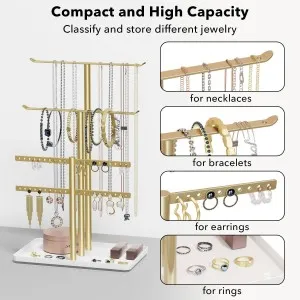
Richpack Practical Affordable Jewelry Display Solutions for Wholesale Buyers | Perfect for Suppliers Seeking Budget-Friendly, High-Volume Display Options
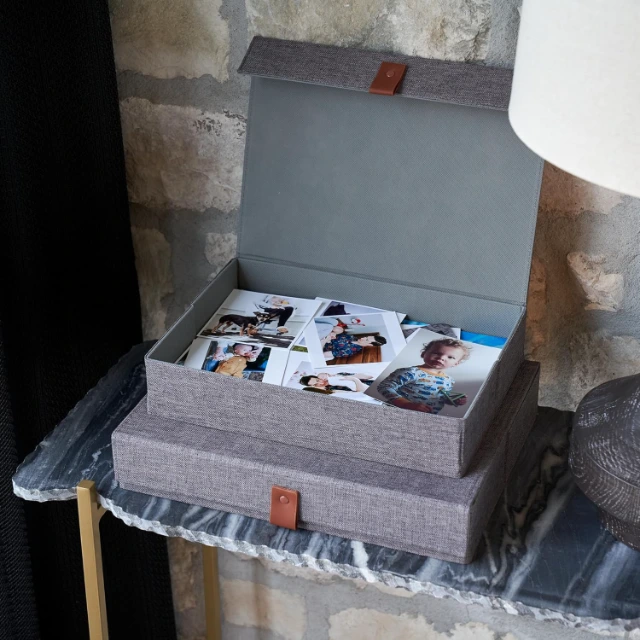
Warm-Heartedly Nostalgic Memory Boxes | Made from Diverse Materials | Preserving Precious Memories
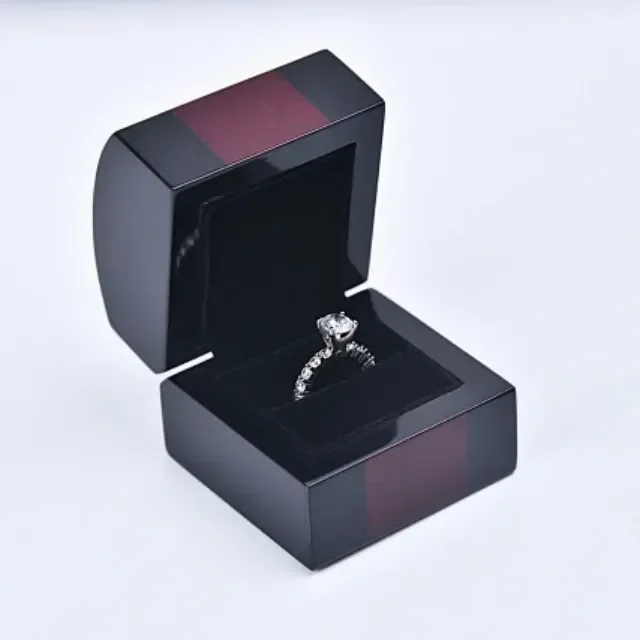
Wholesale Custom Wooden Jewelry Boxes for Jewelry Brands | Sustainable and Durable Packaging Bulk Order Options Available

Durable Earring Card Display Stands for Retail and Event Showcases – Sleek Earring Card Display Stand Solutions by Richpack to Highlight Your Jewelry
View More
Intelligent Magnetically Stackable Jewelry Boxes | With Compartments for Optimized Jewelry Storage
View More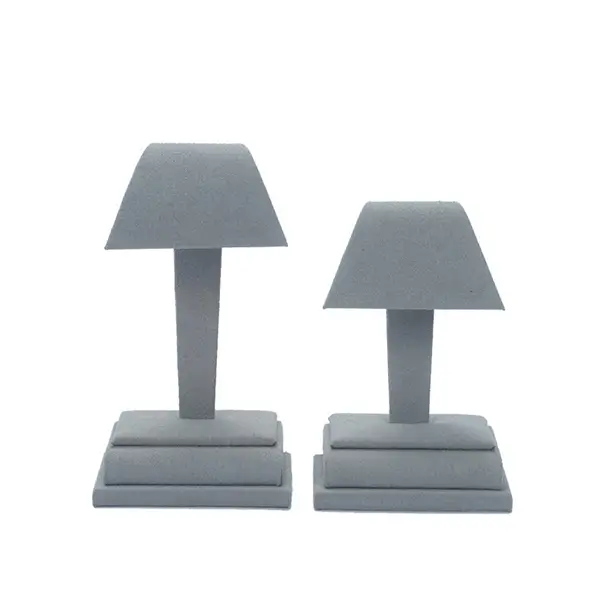
Luxurious Jewelry Display Bust for Showcasing Necklaces and Accessories – Customizable Jewelry Bust Displays Perfect for Retail Stores and Exhibitions
View MoreJust submit your email to get exclusive offers (reply within 12 hours)